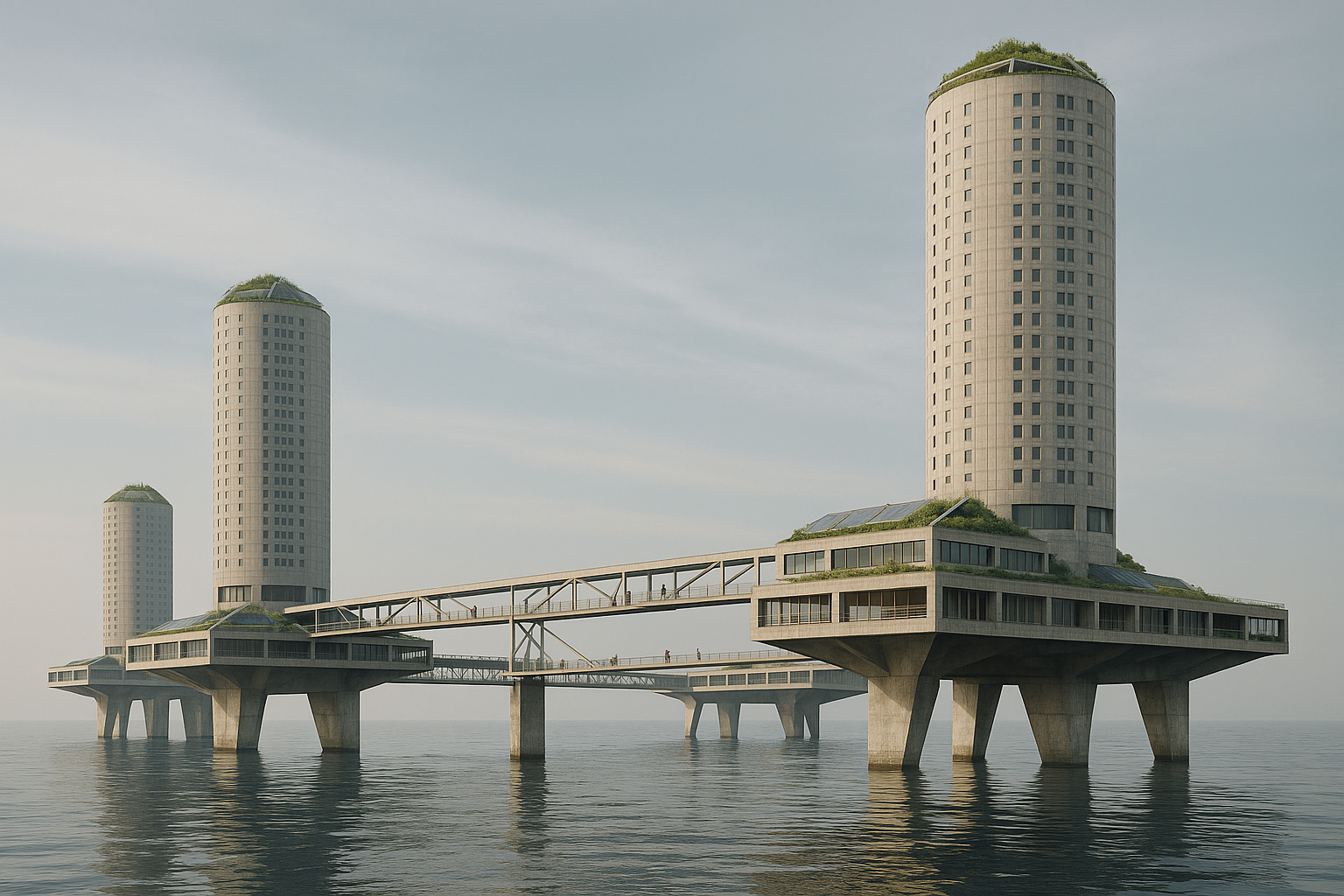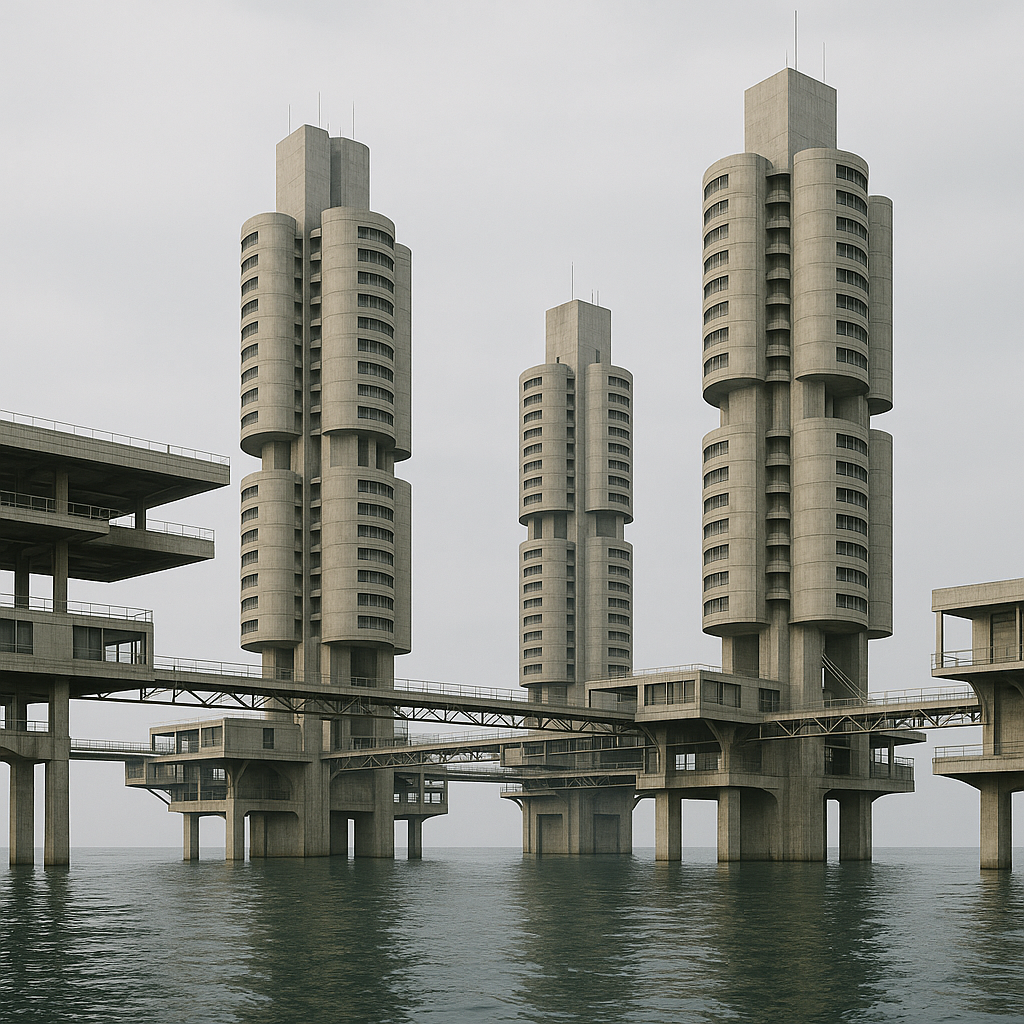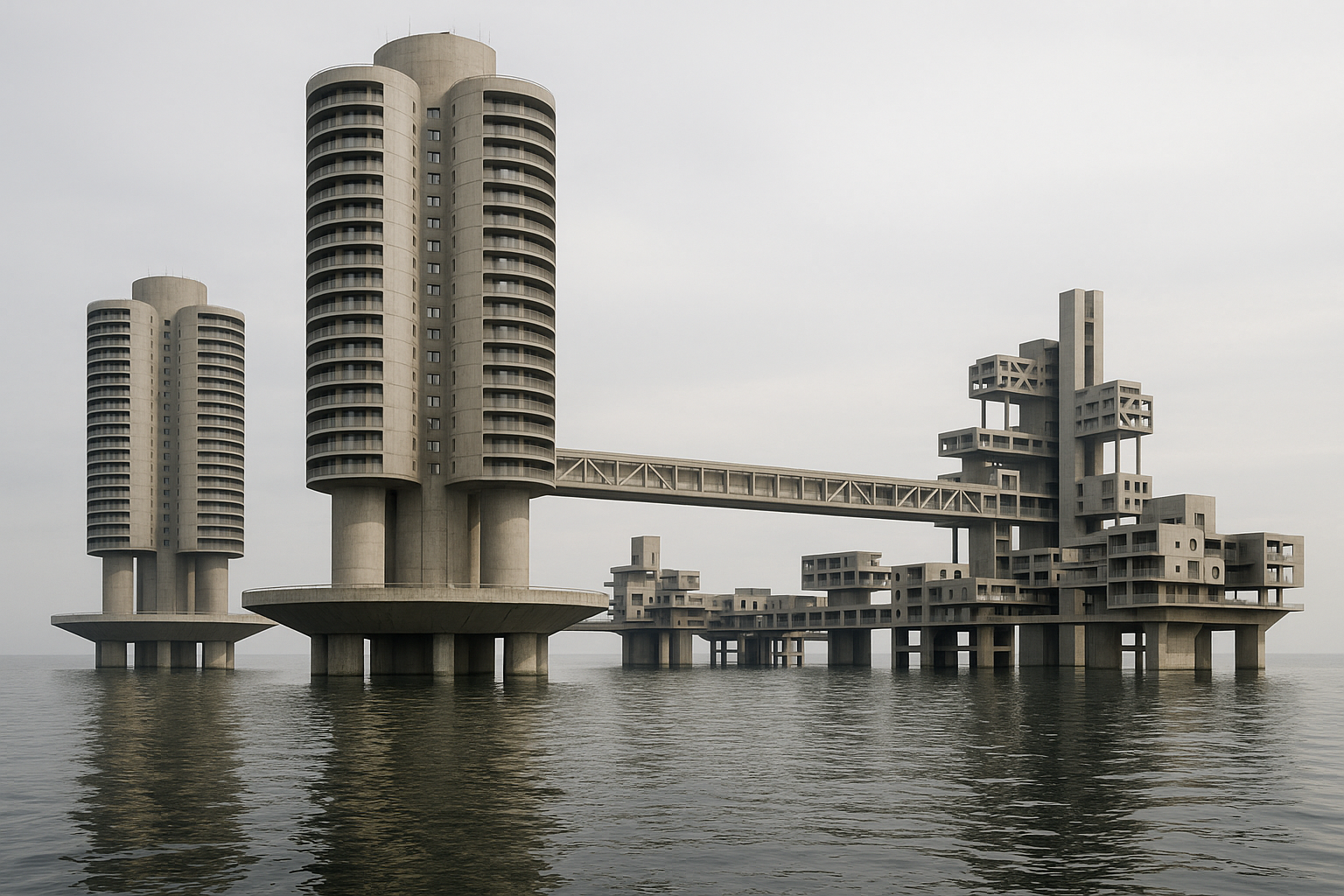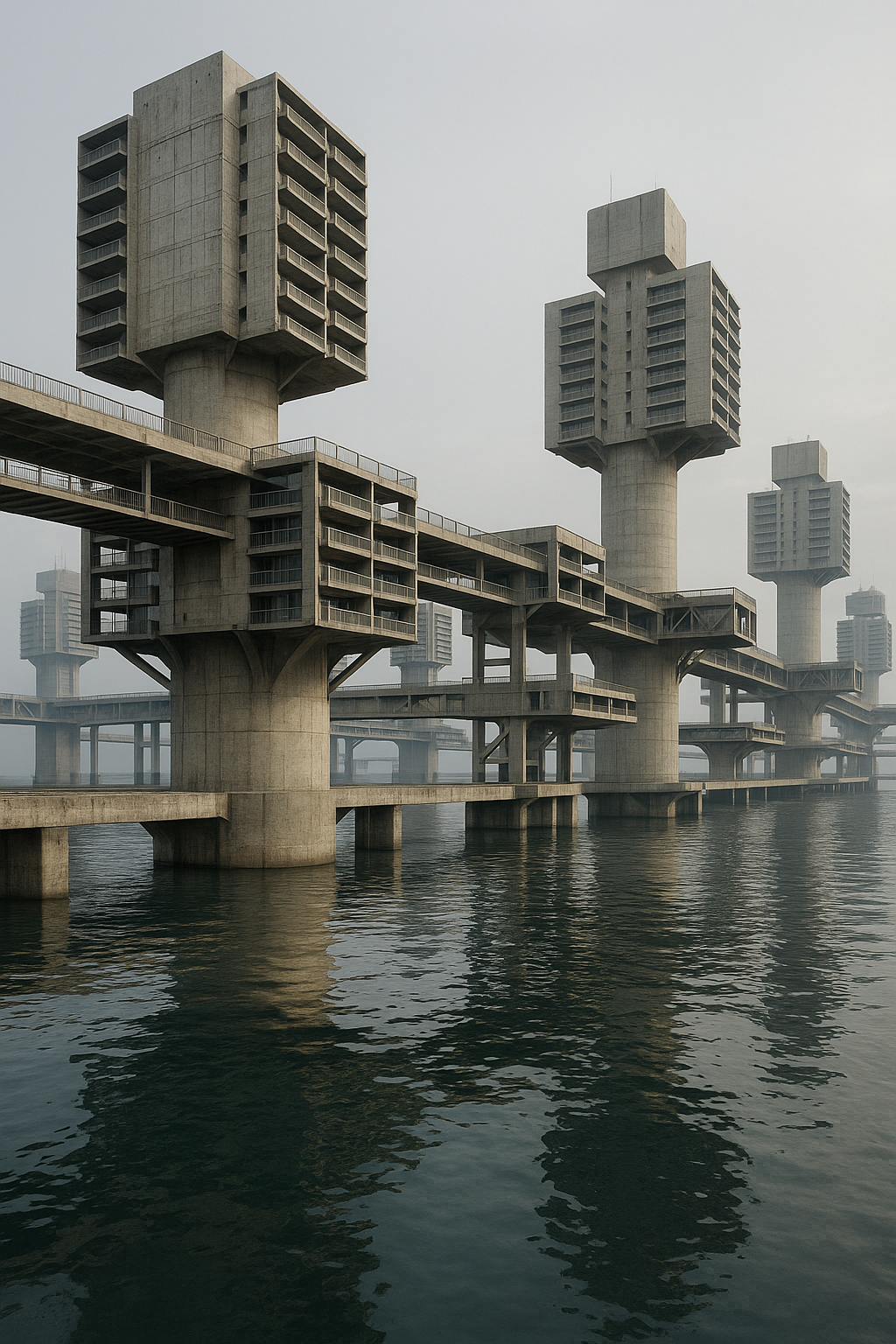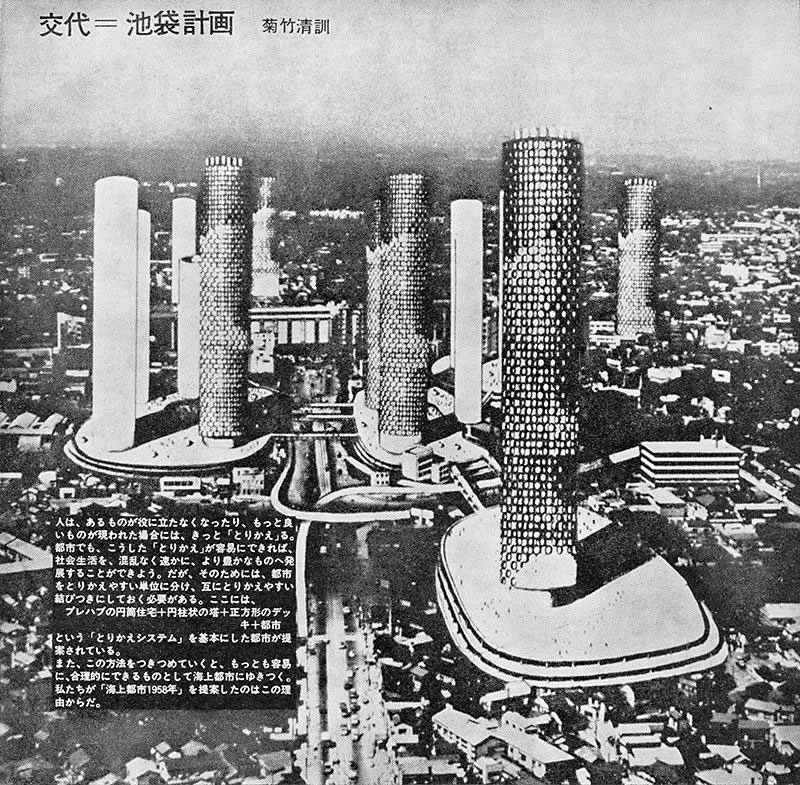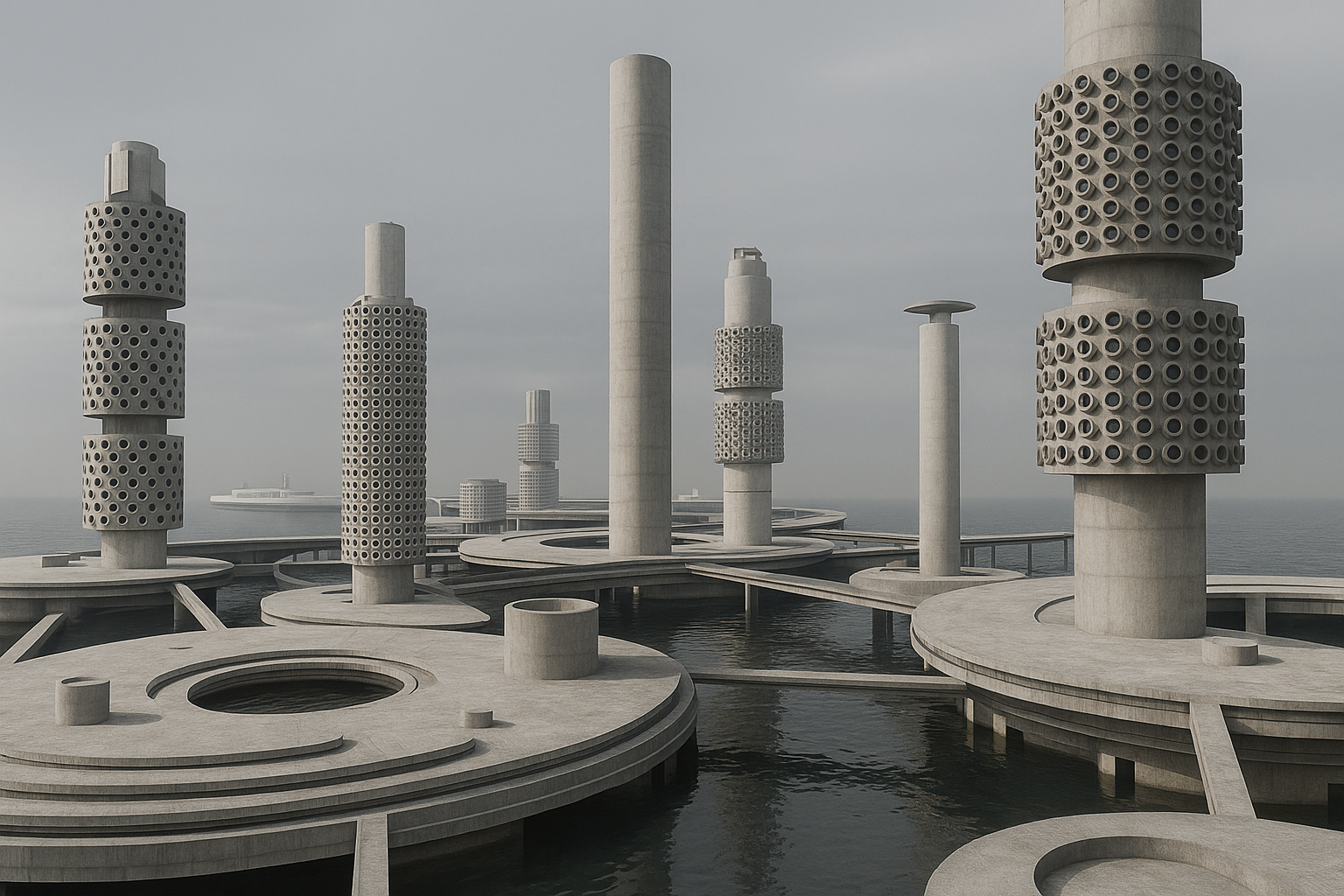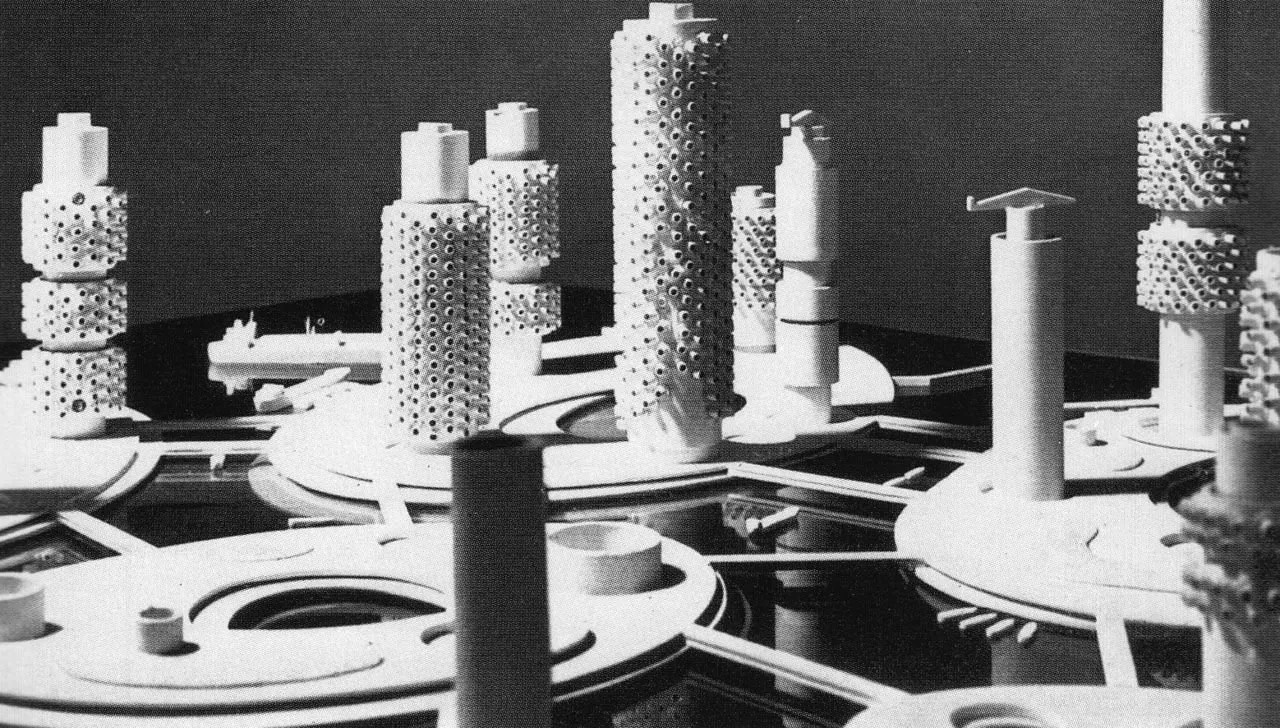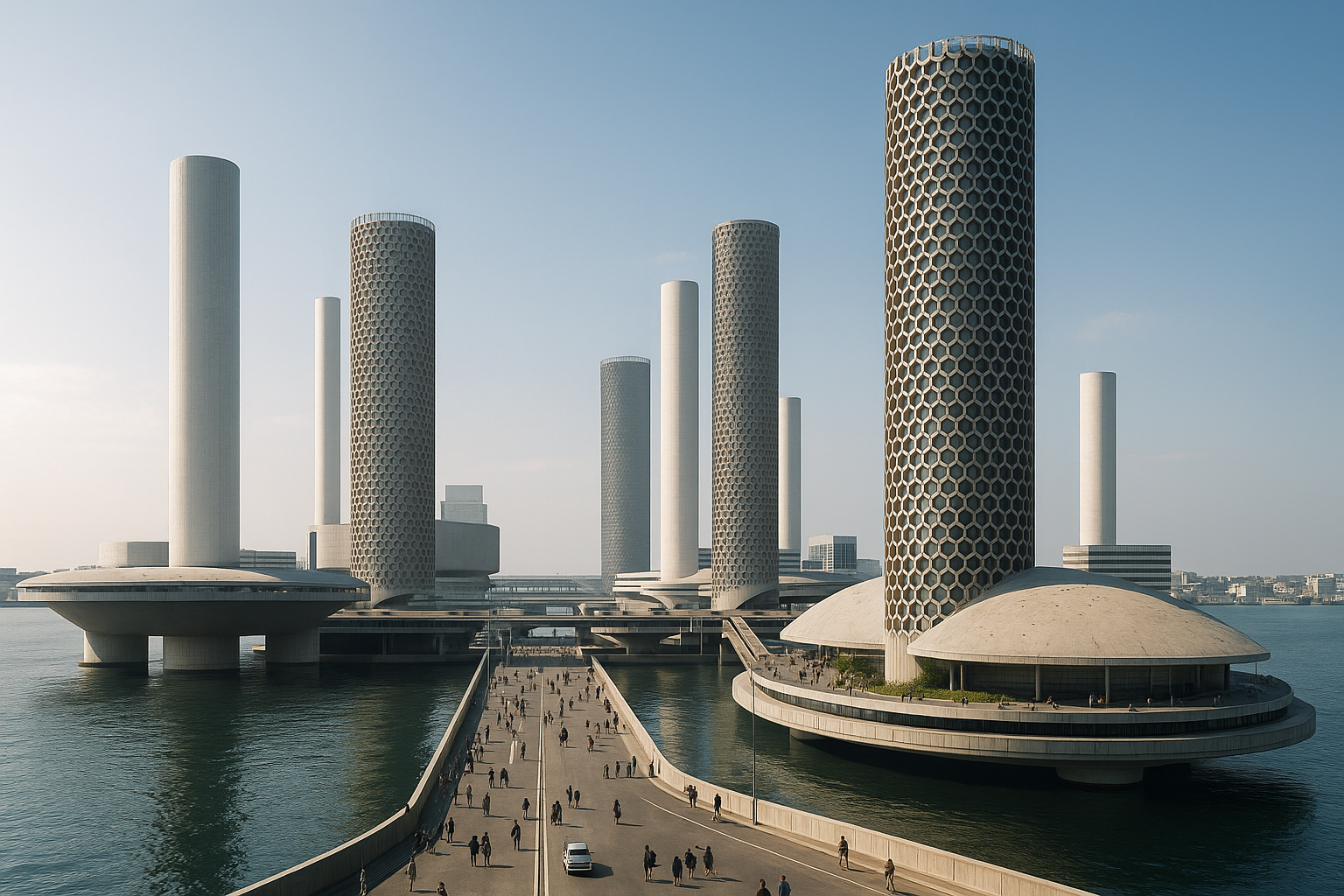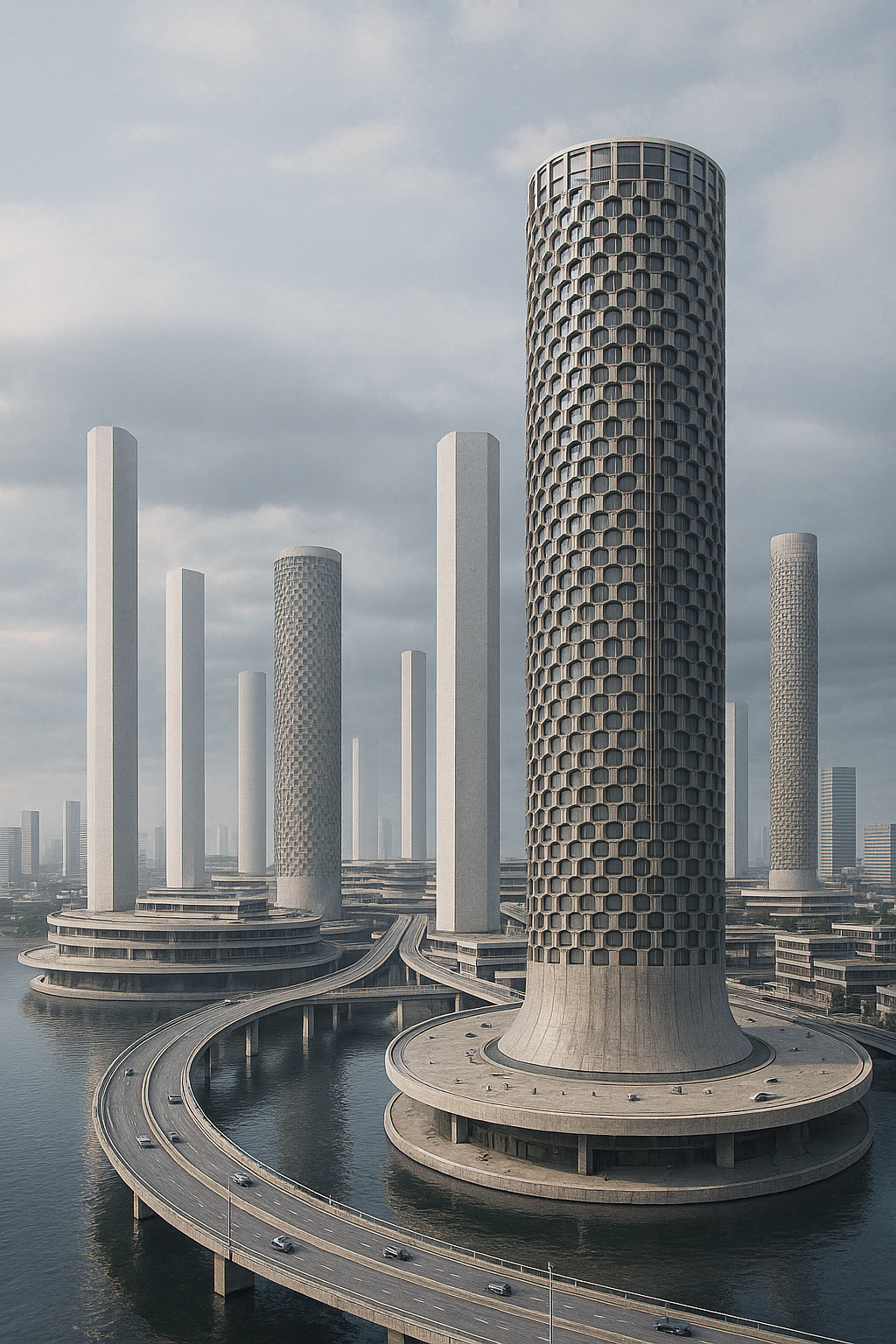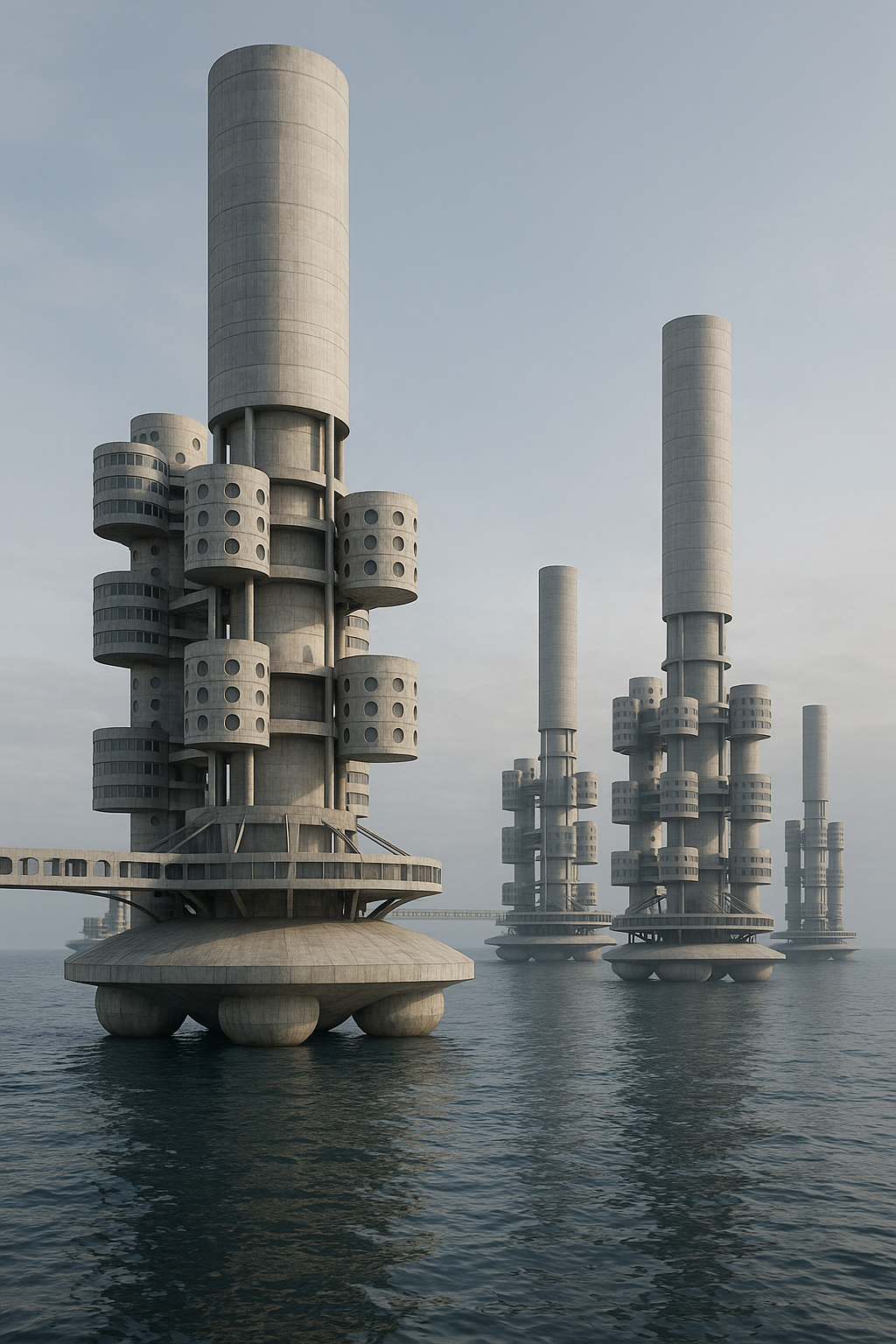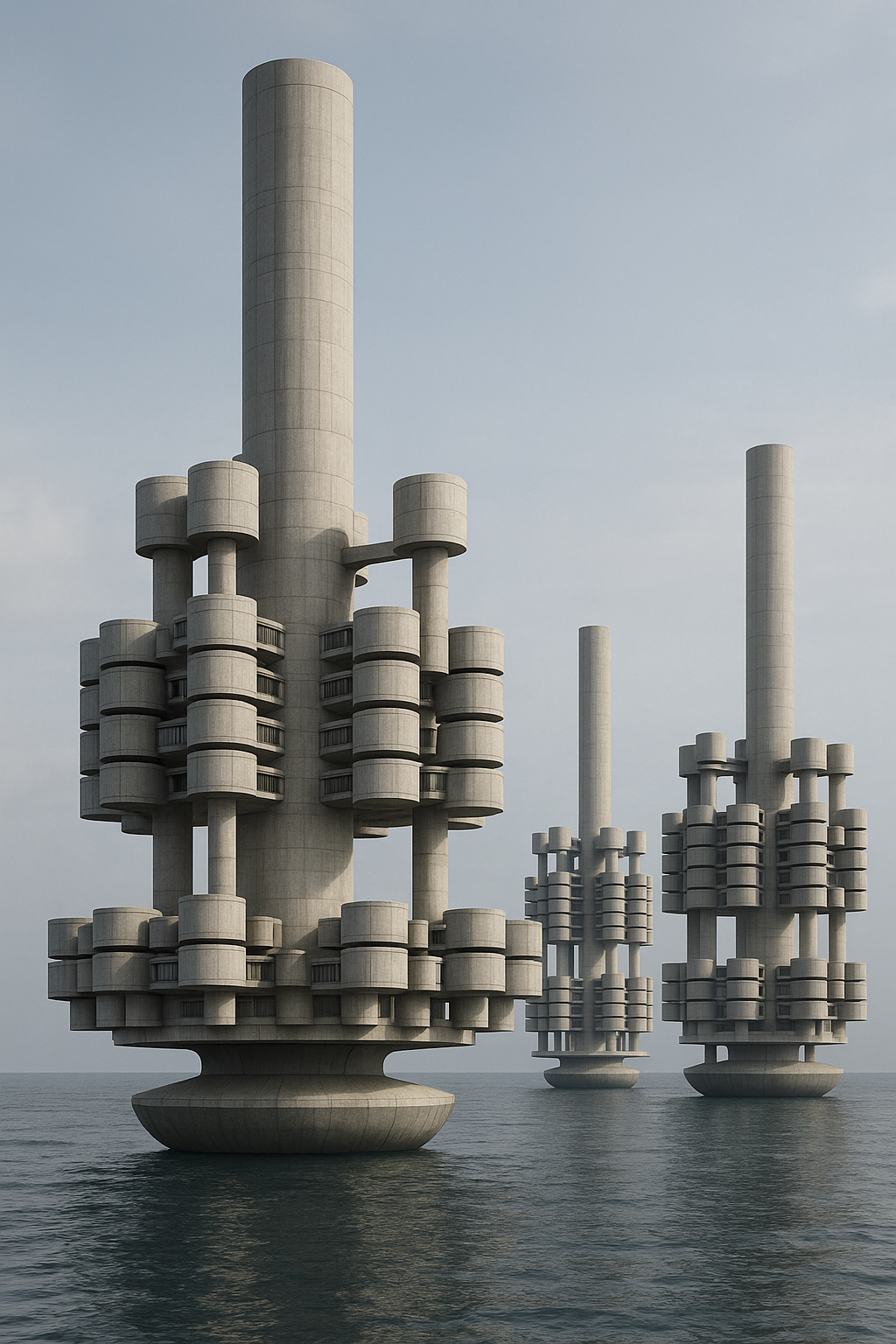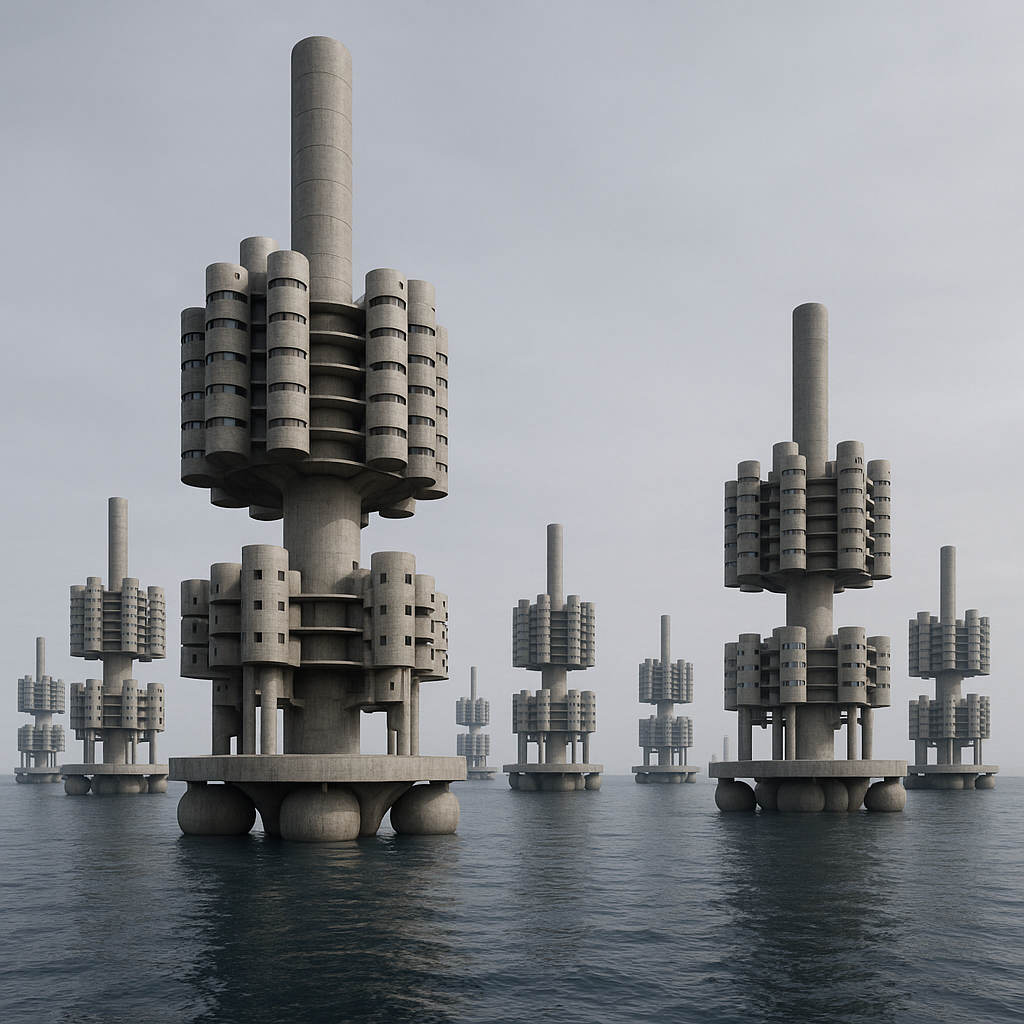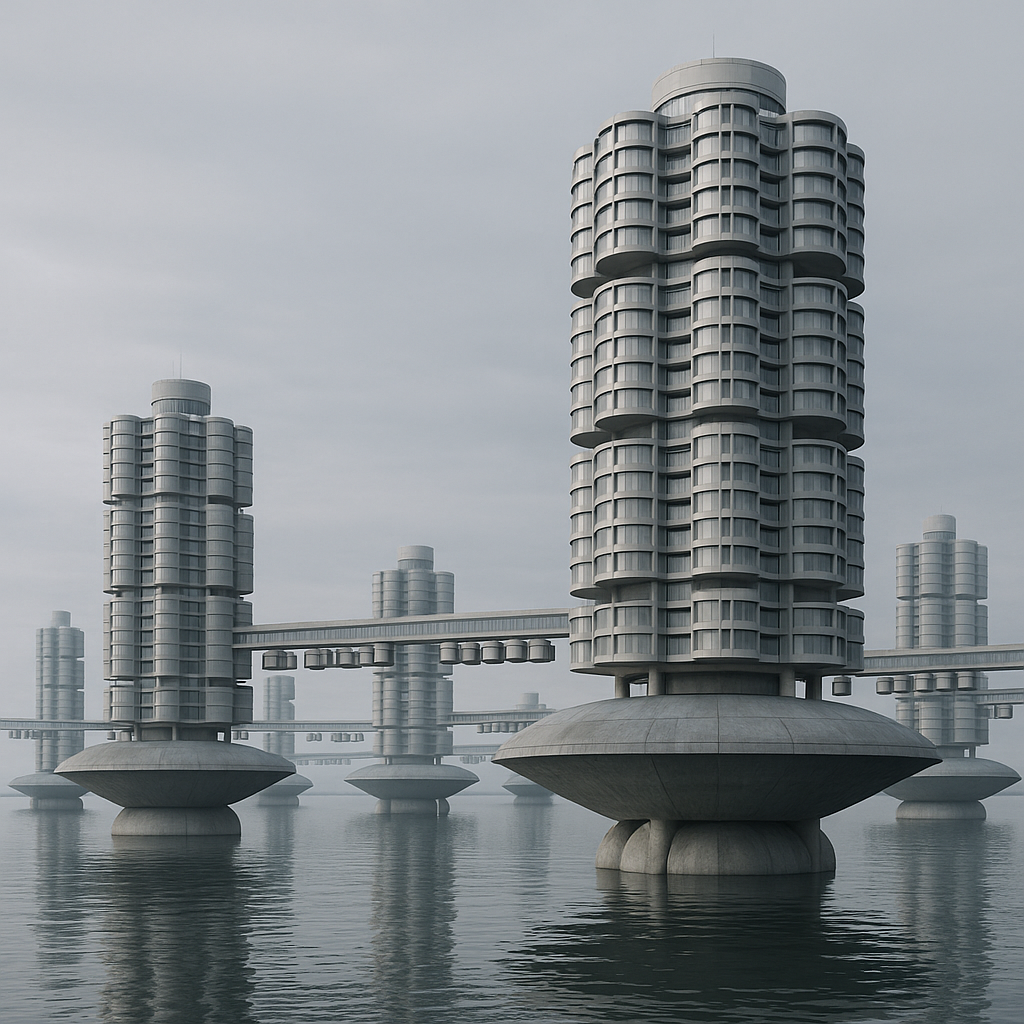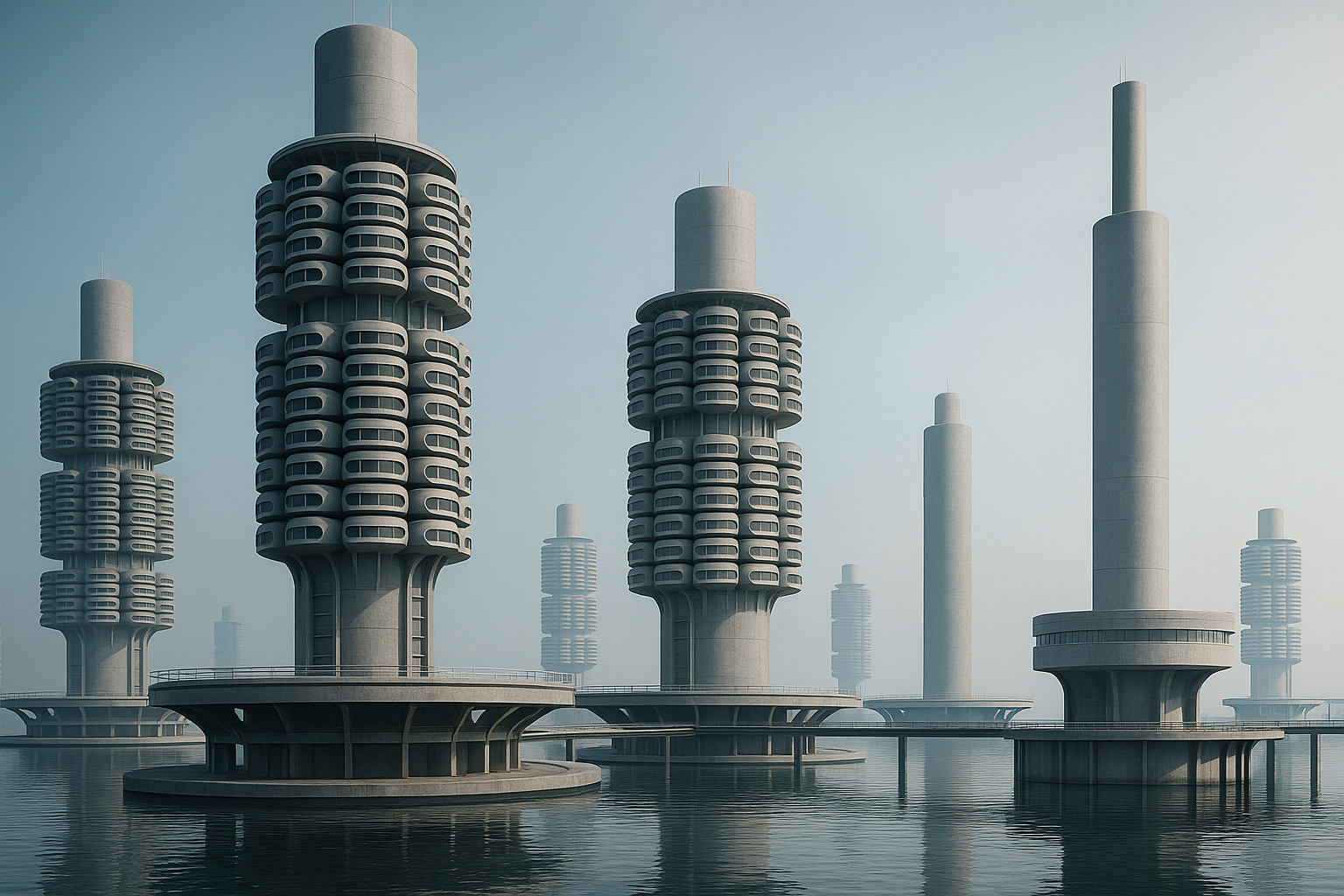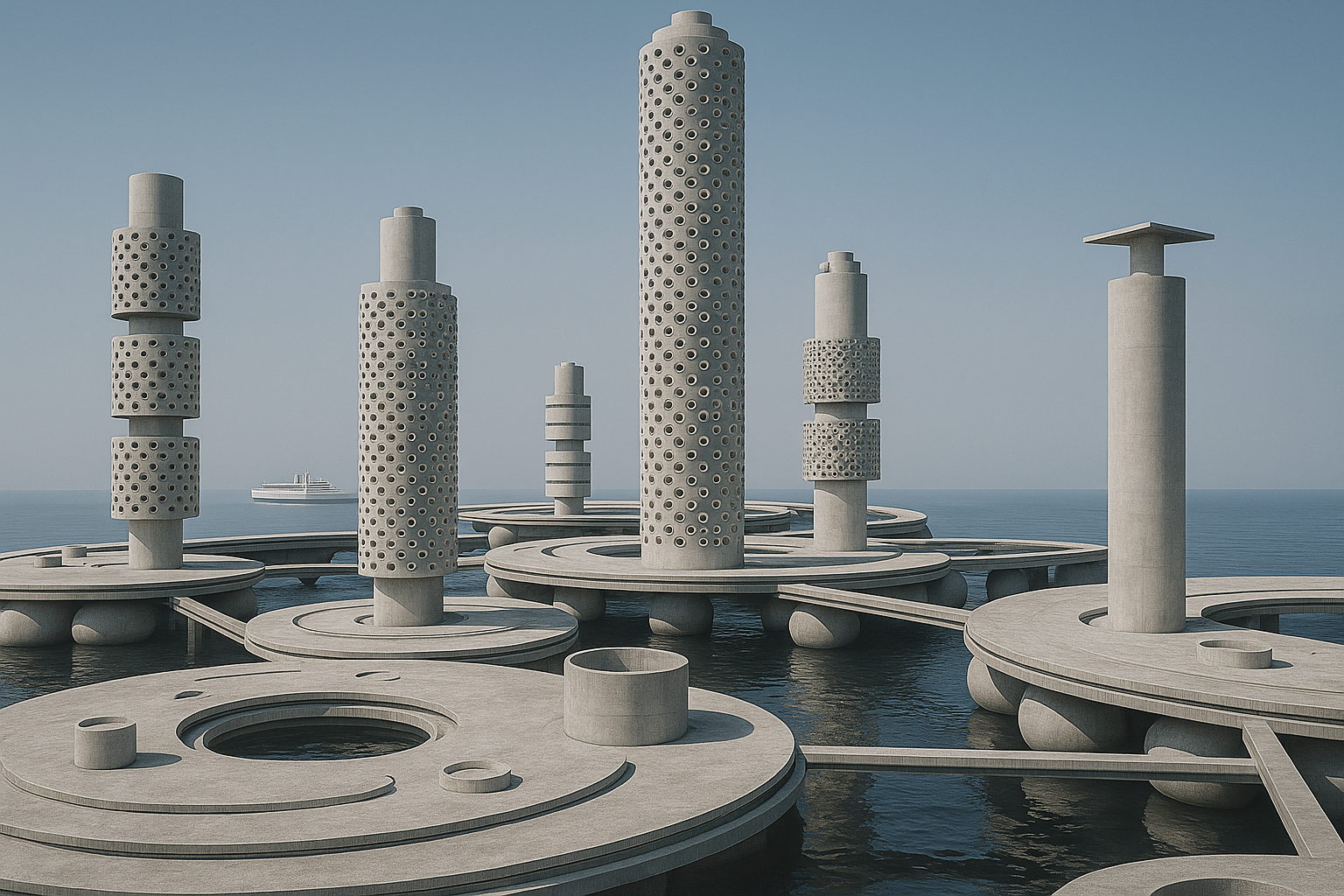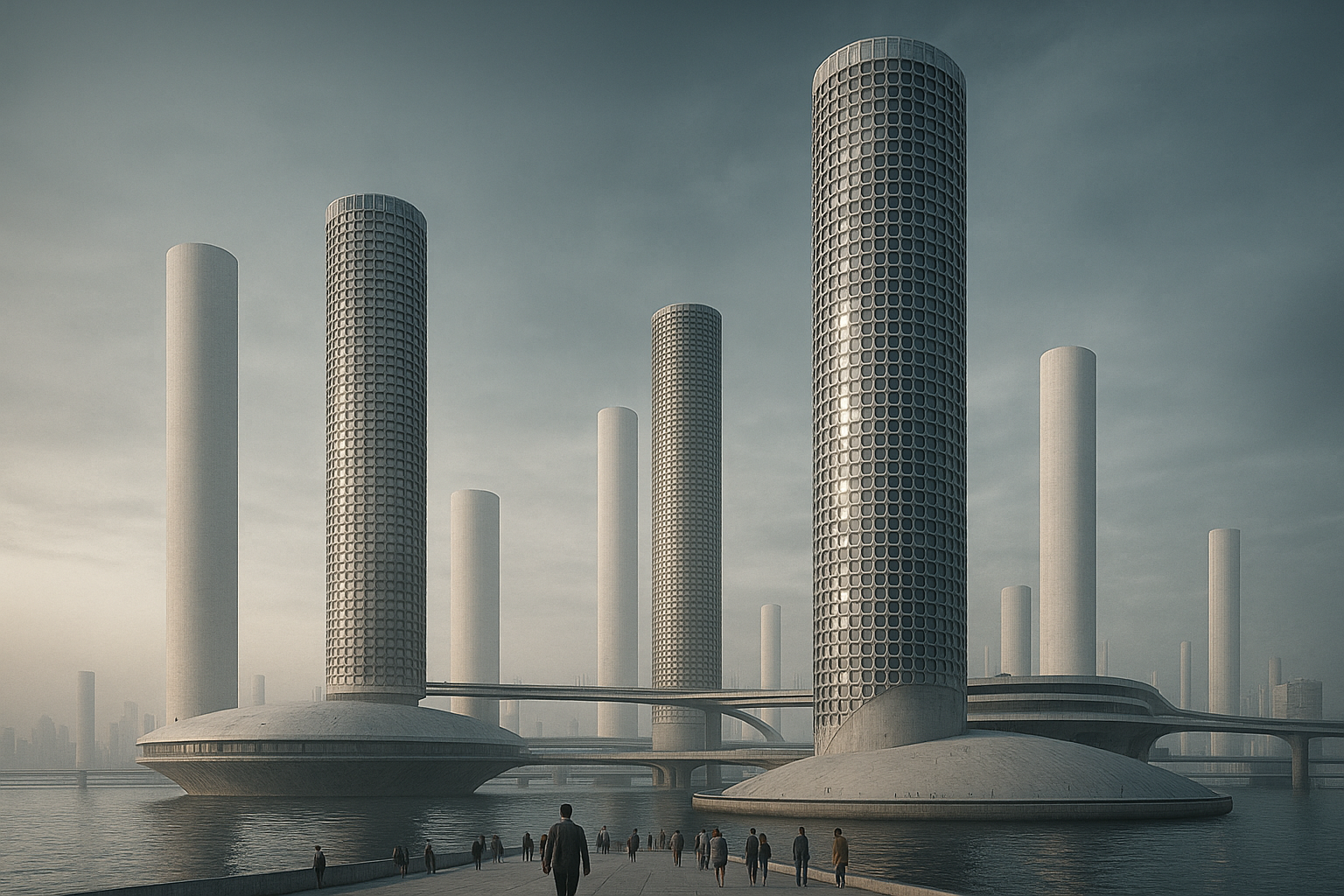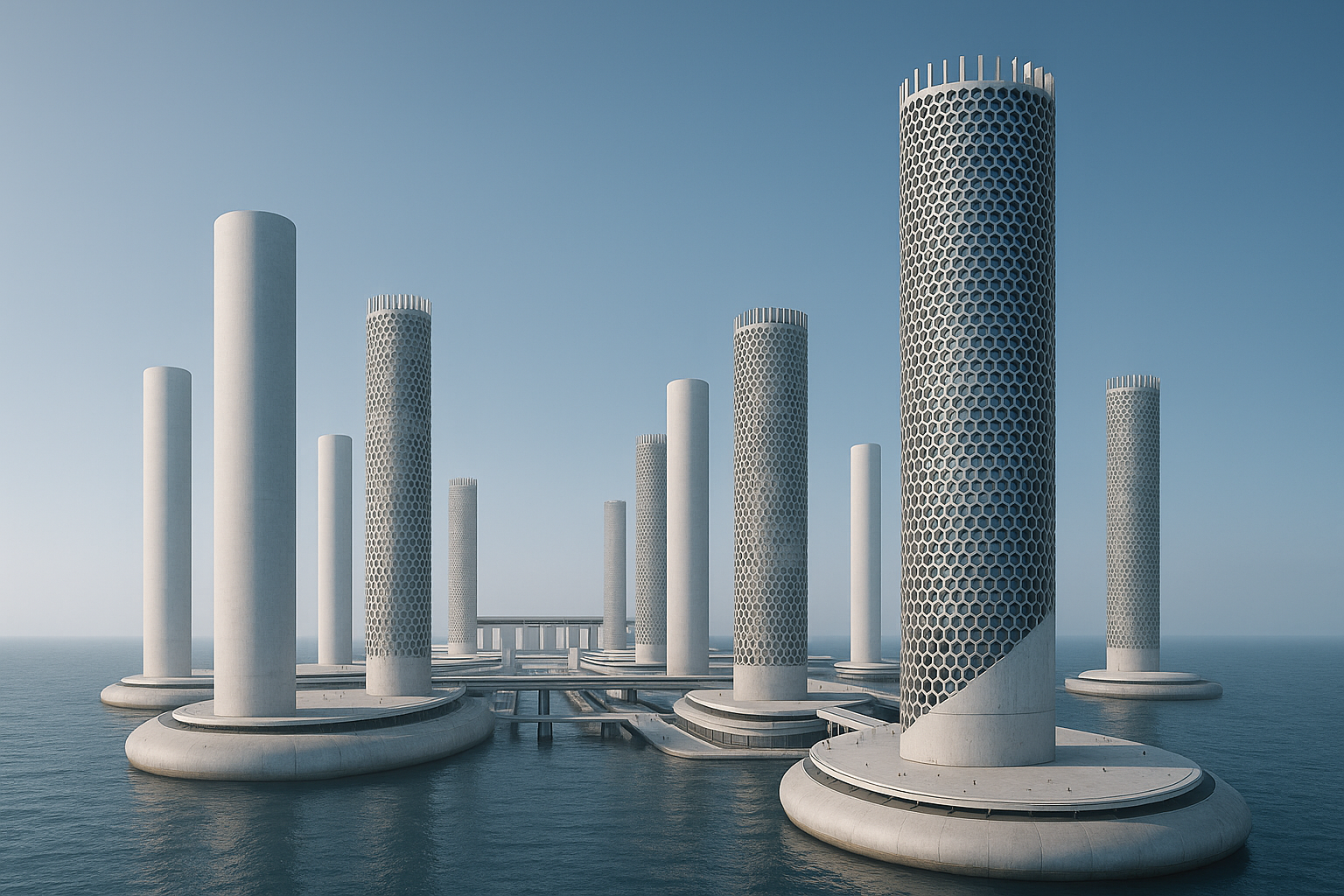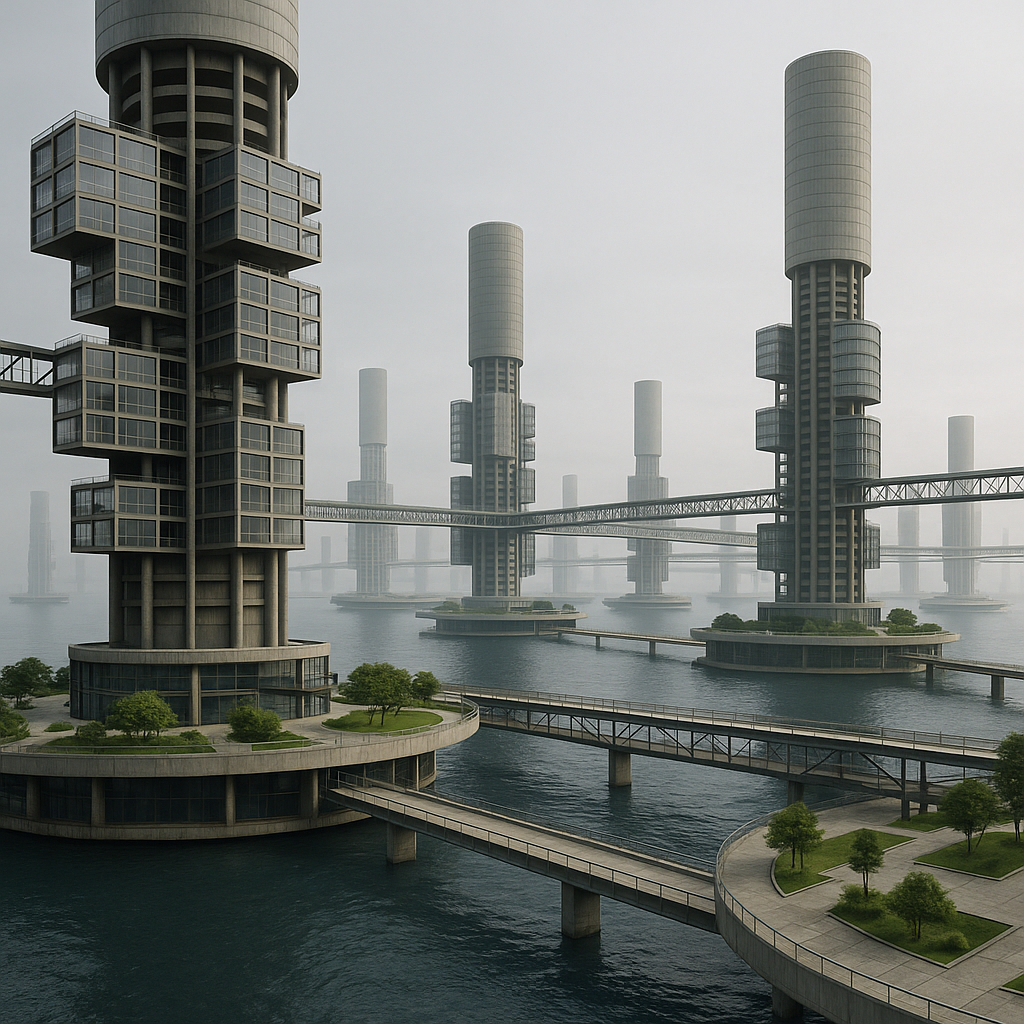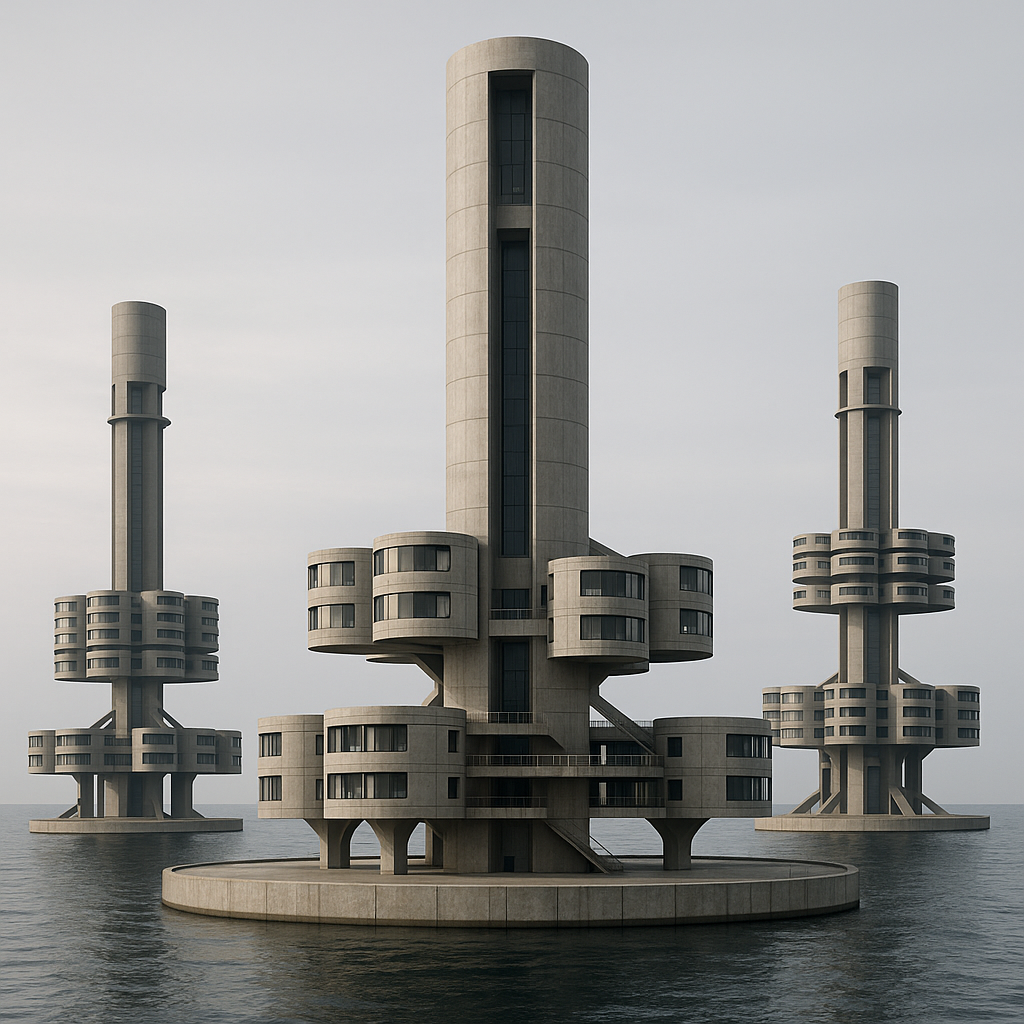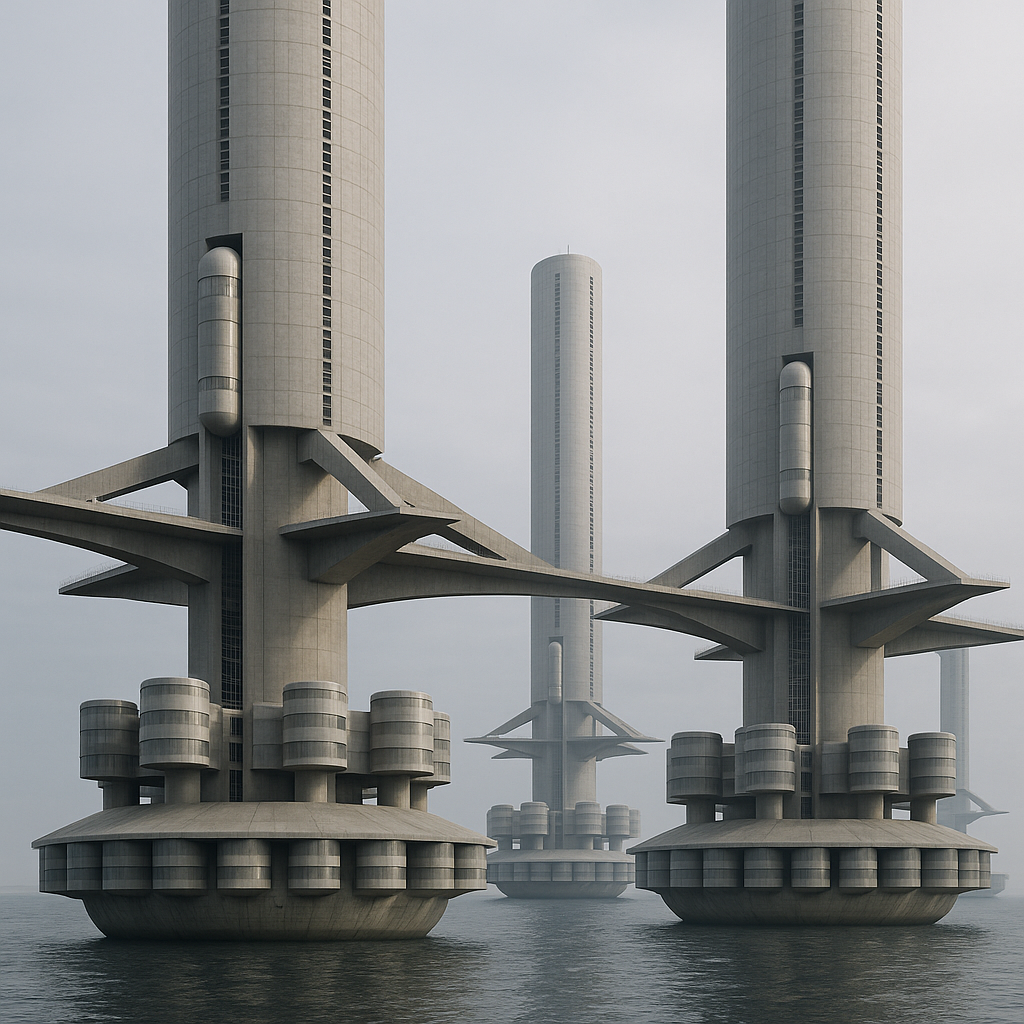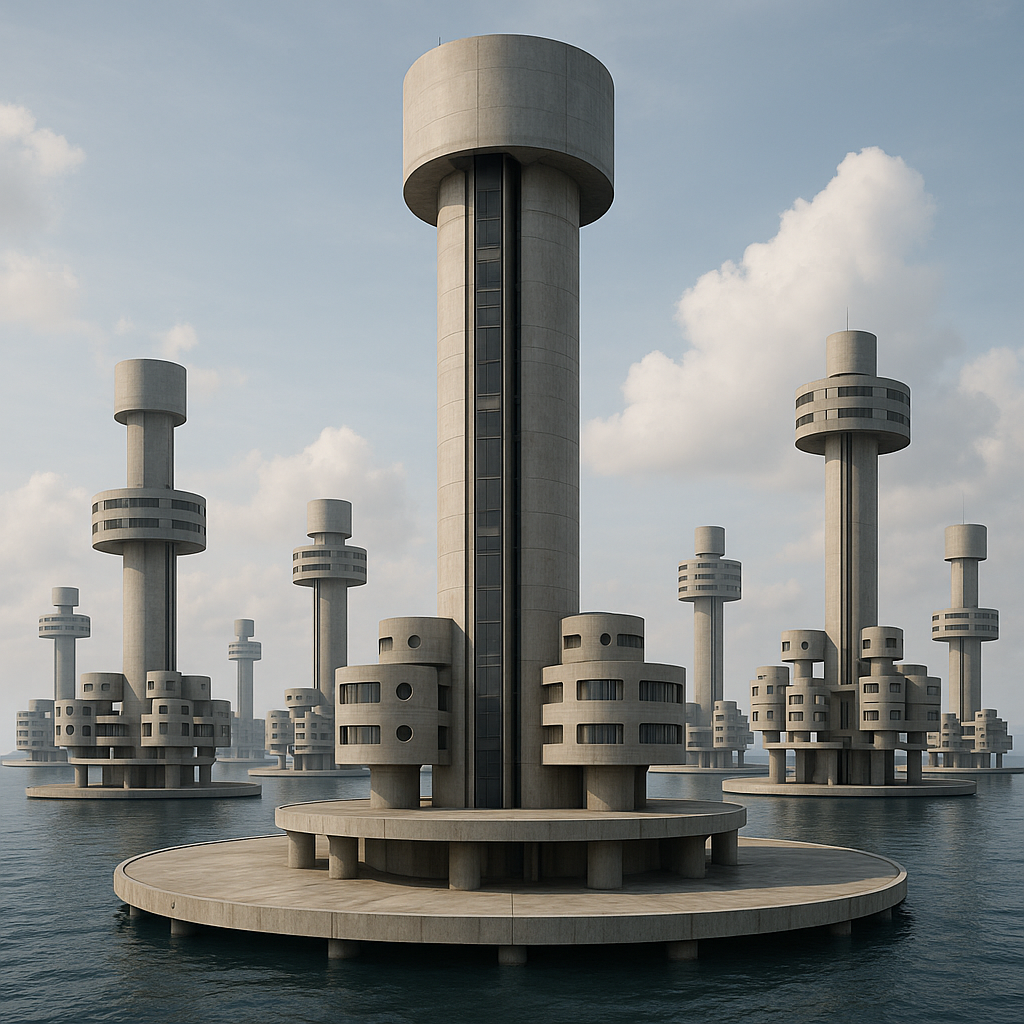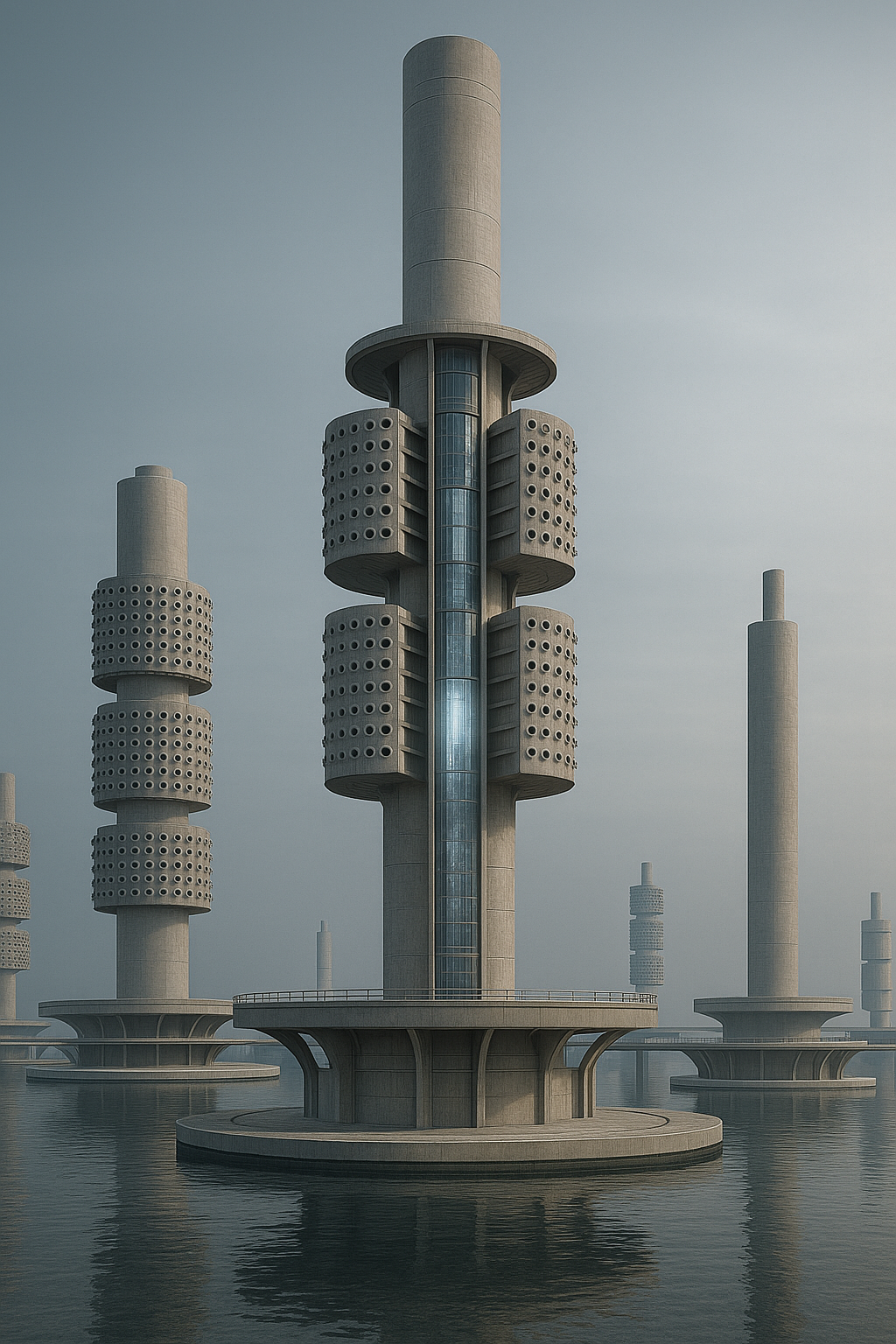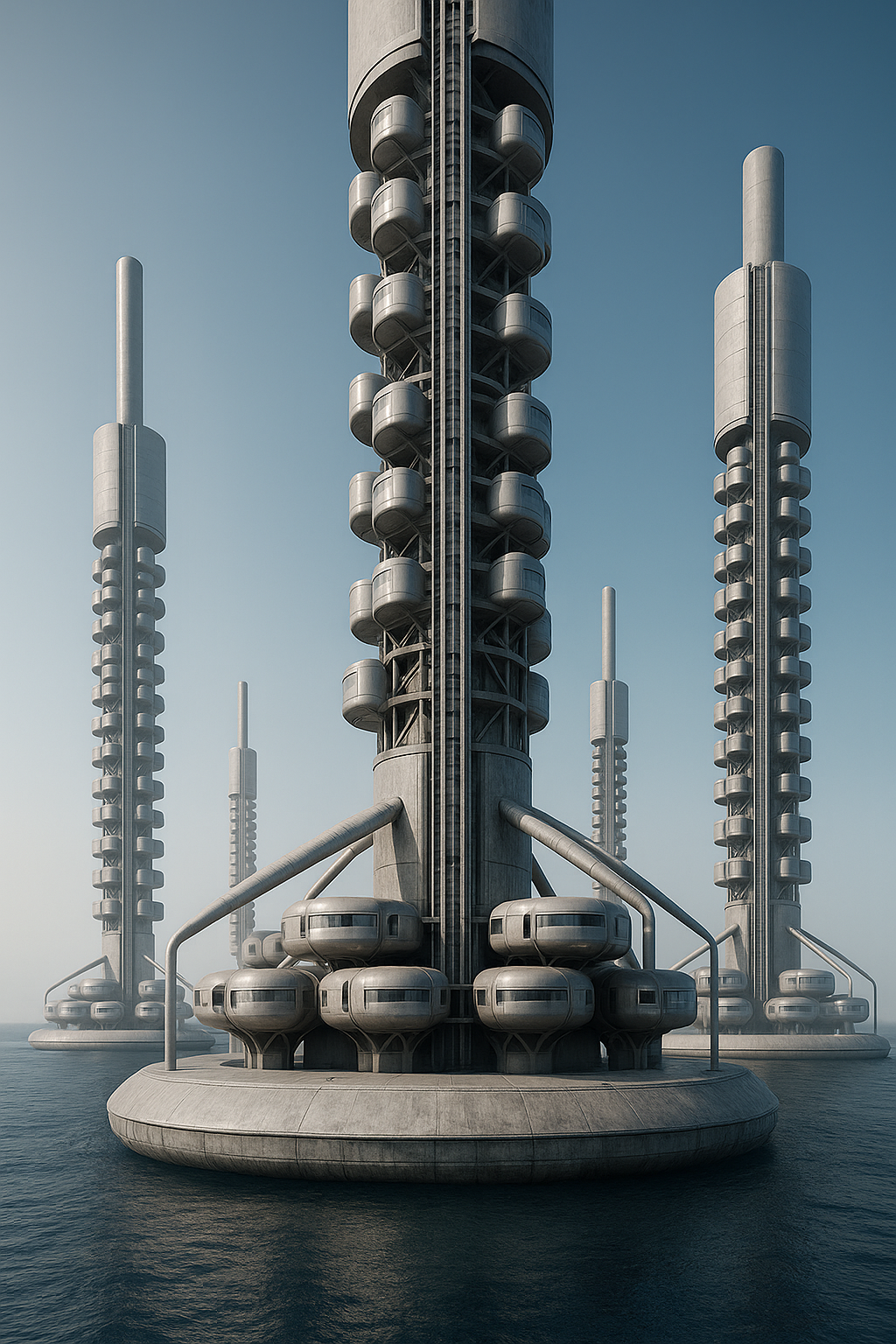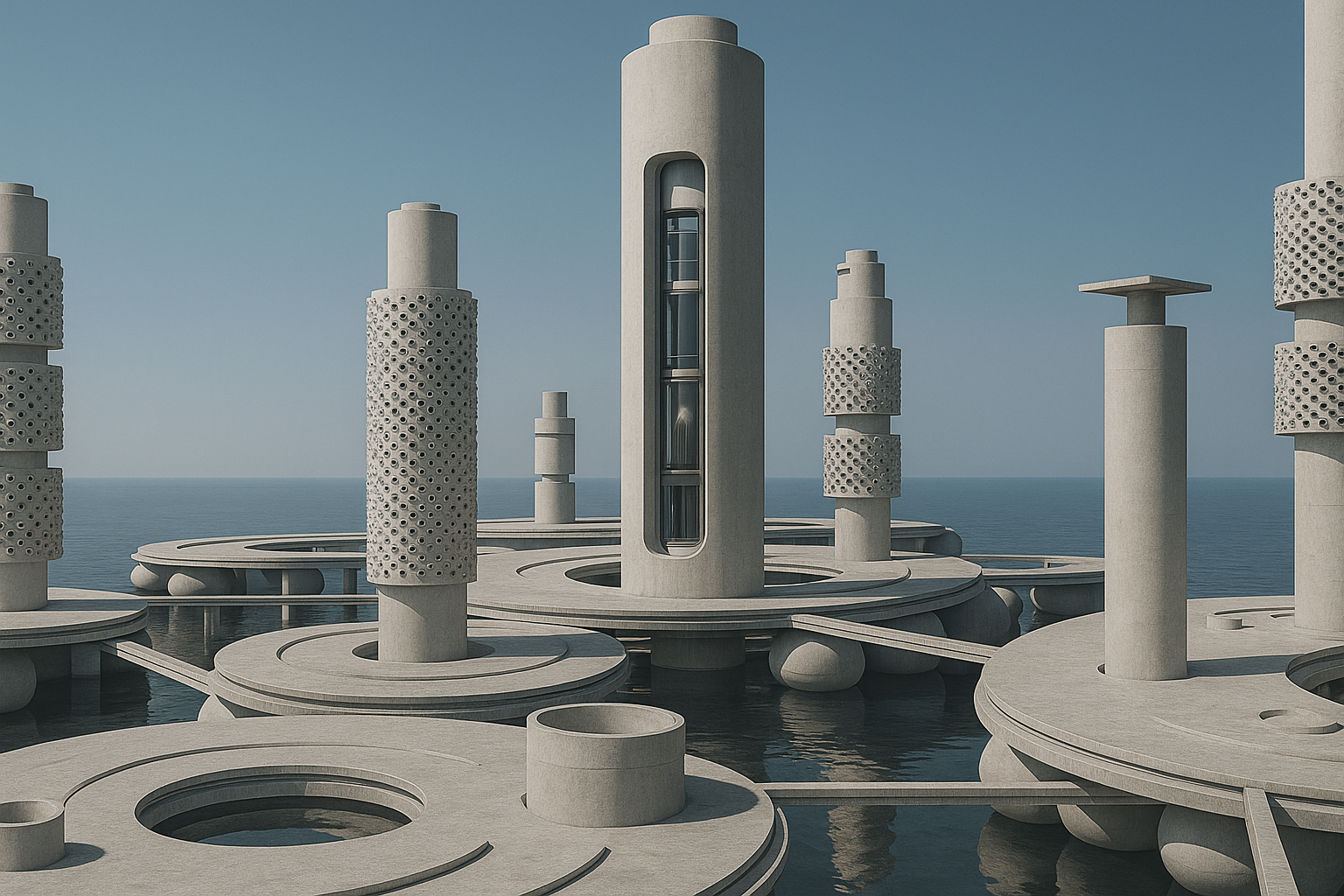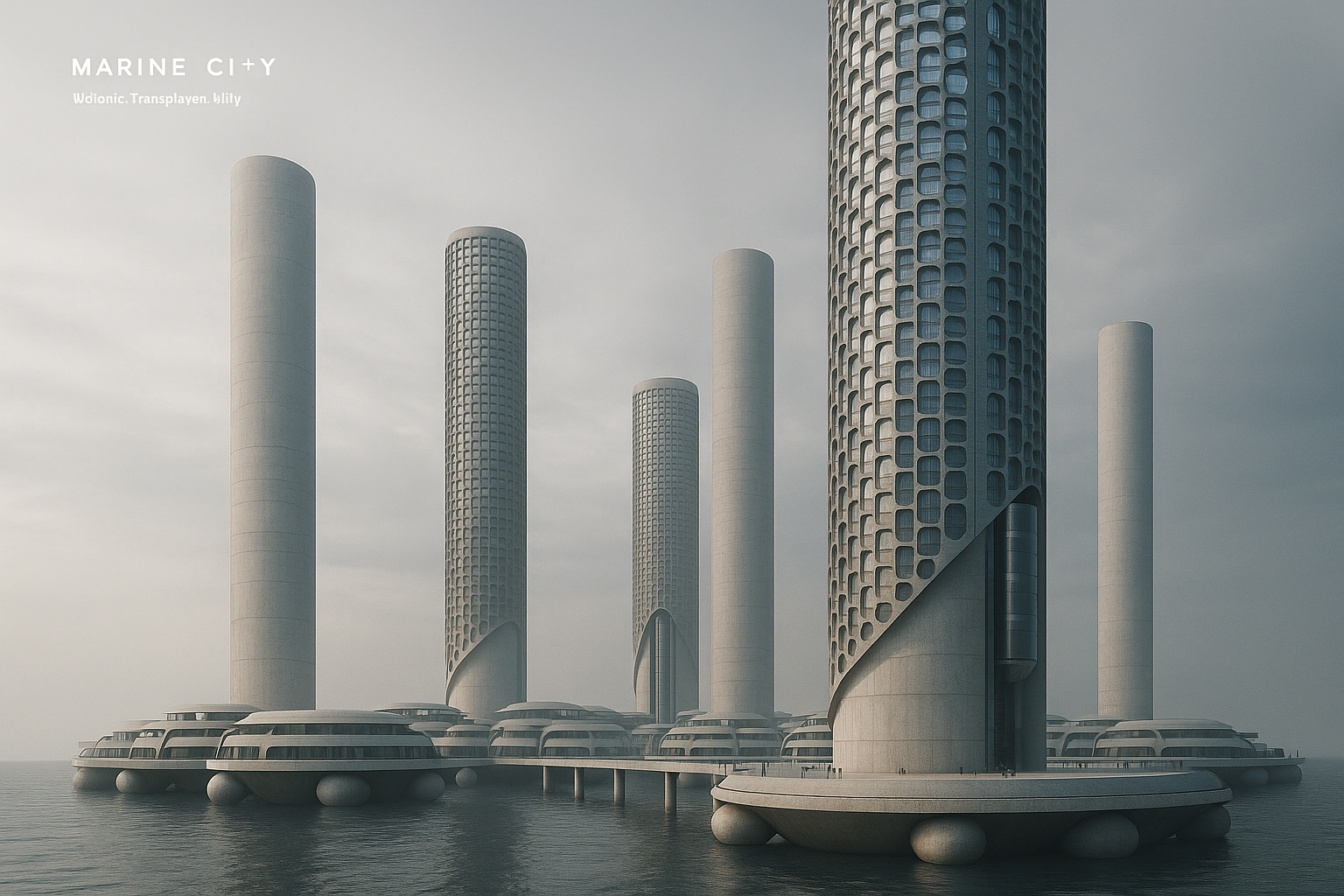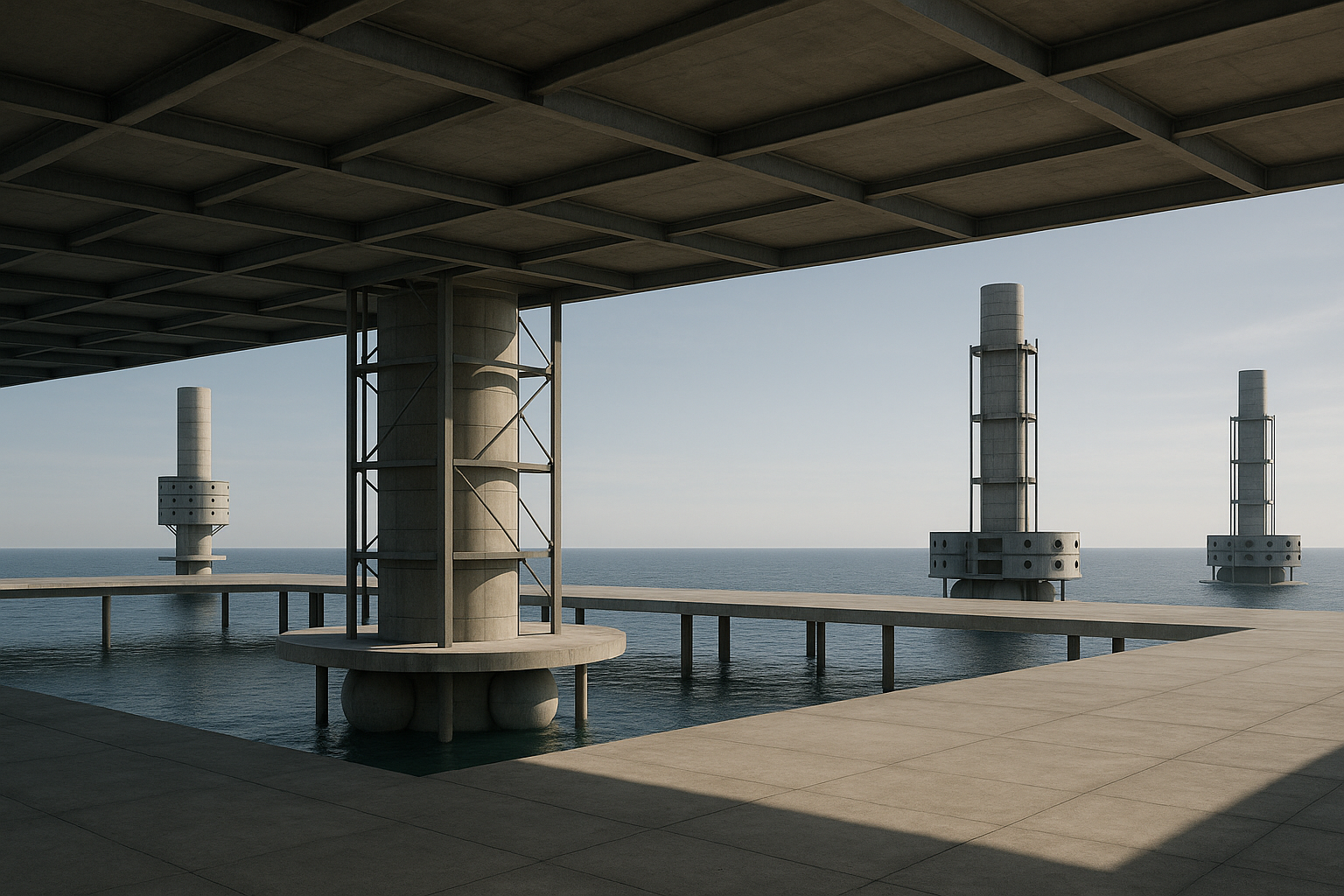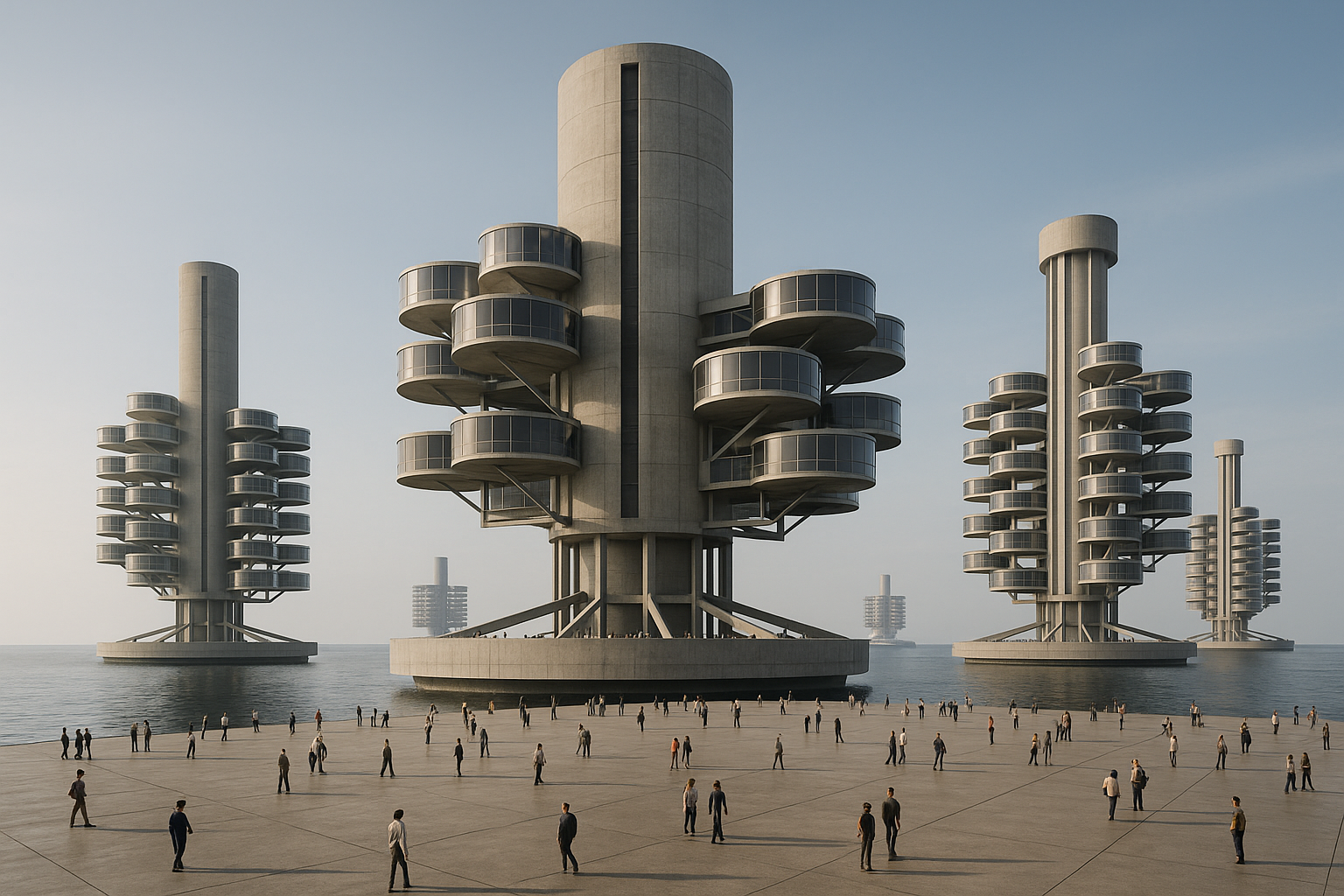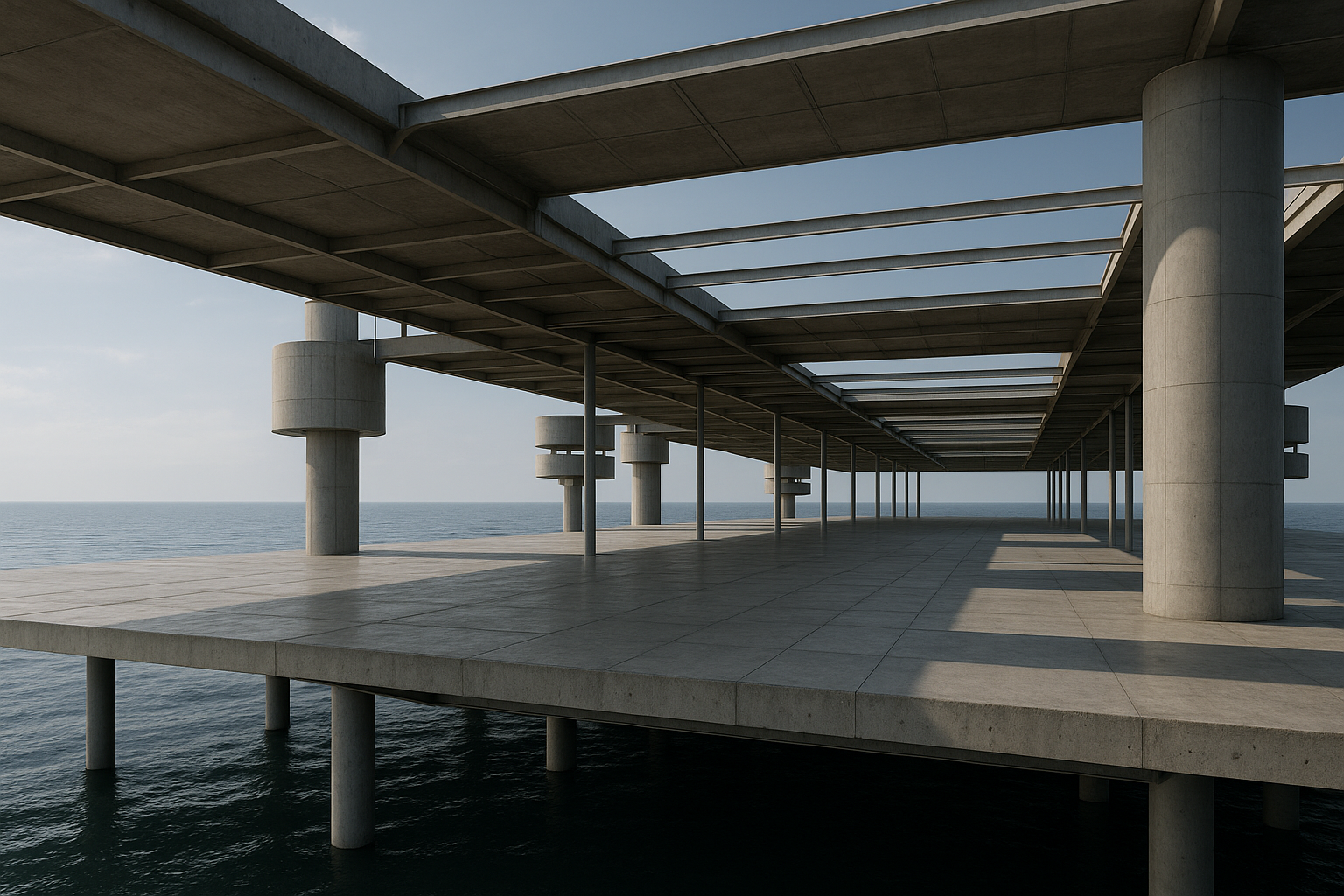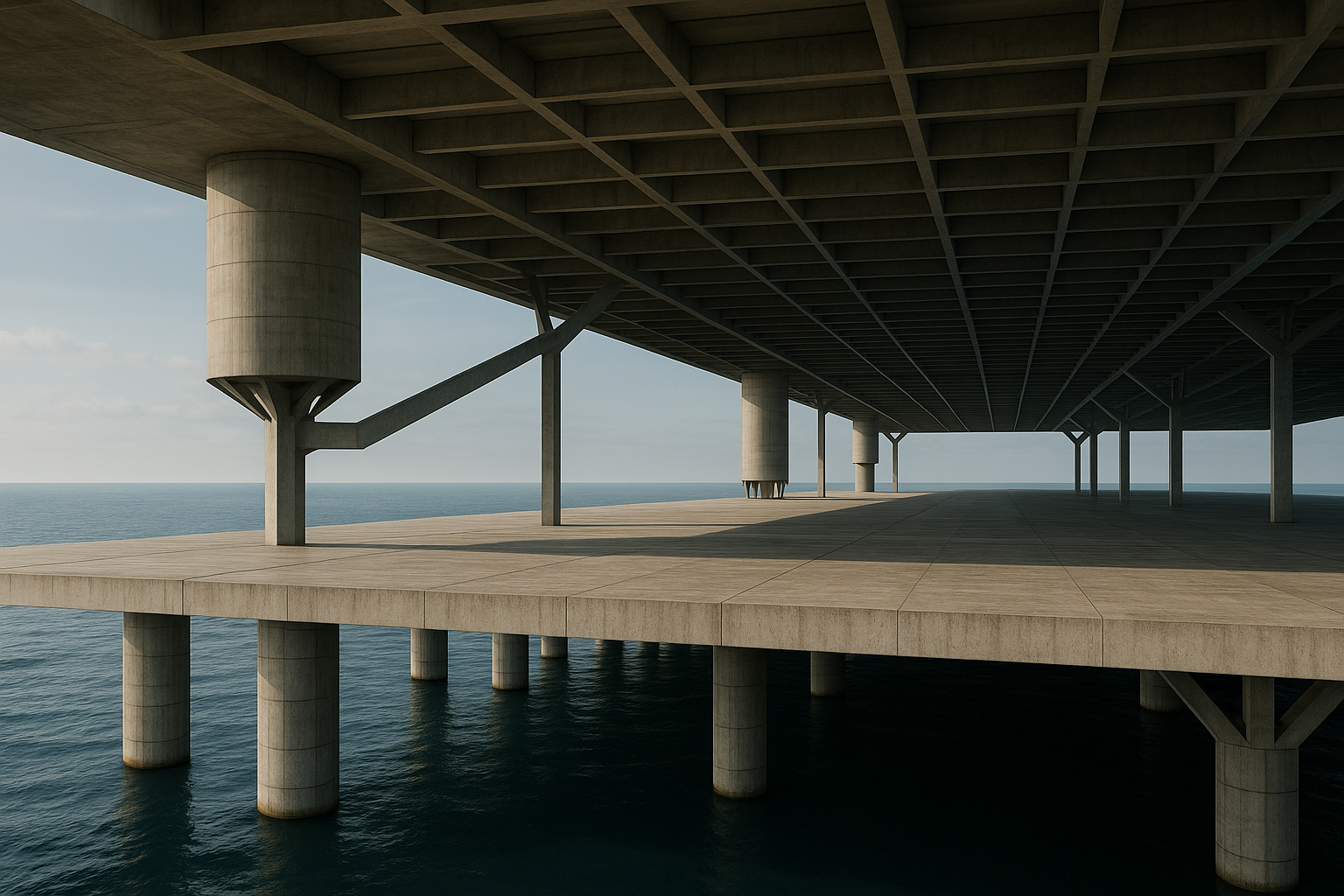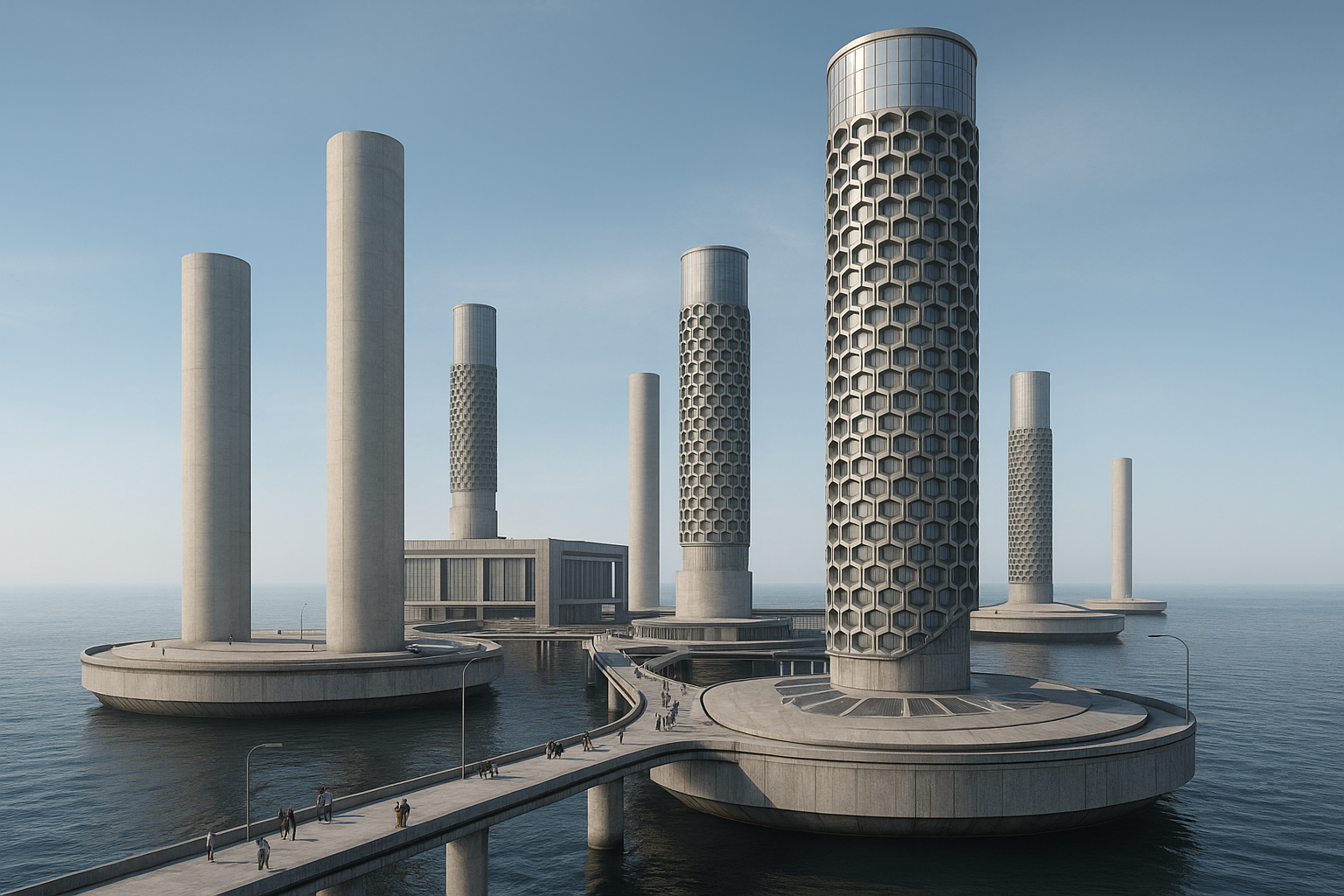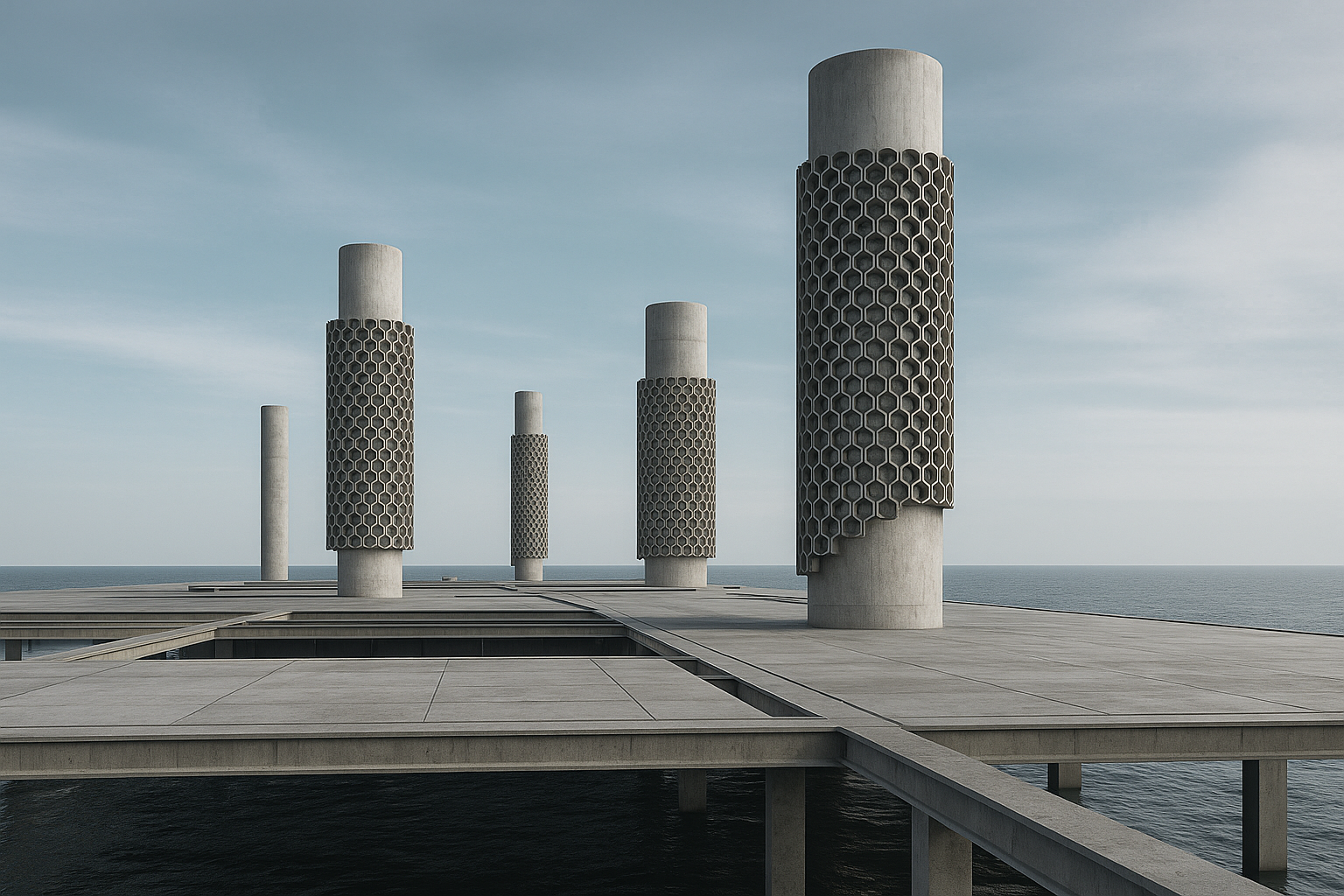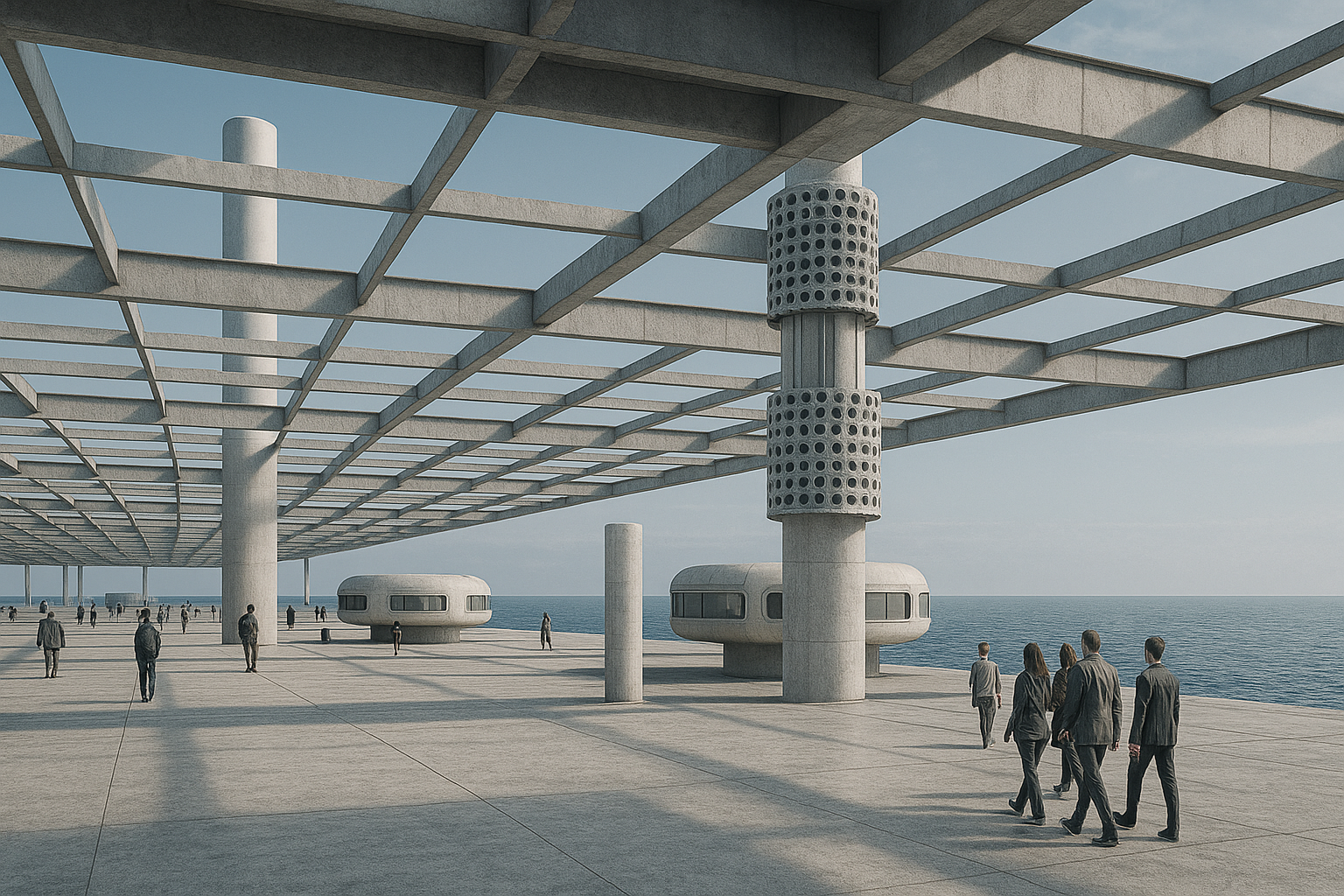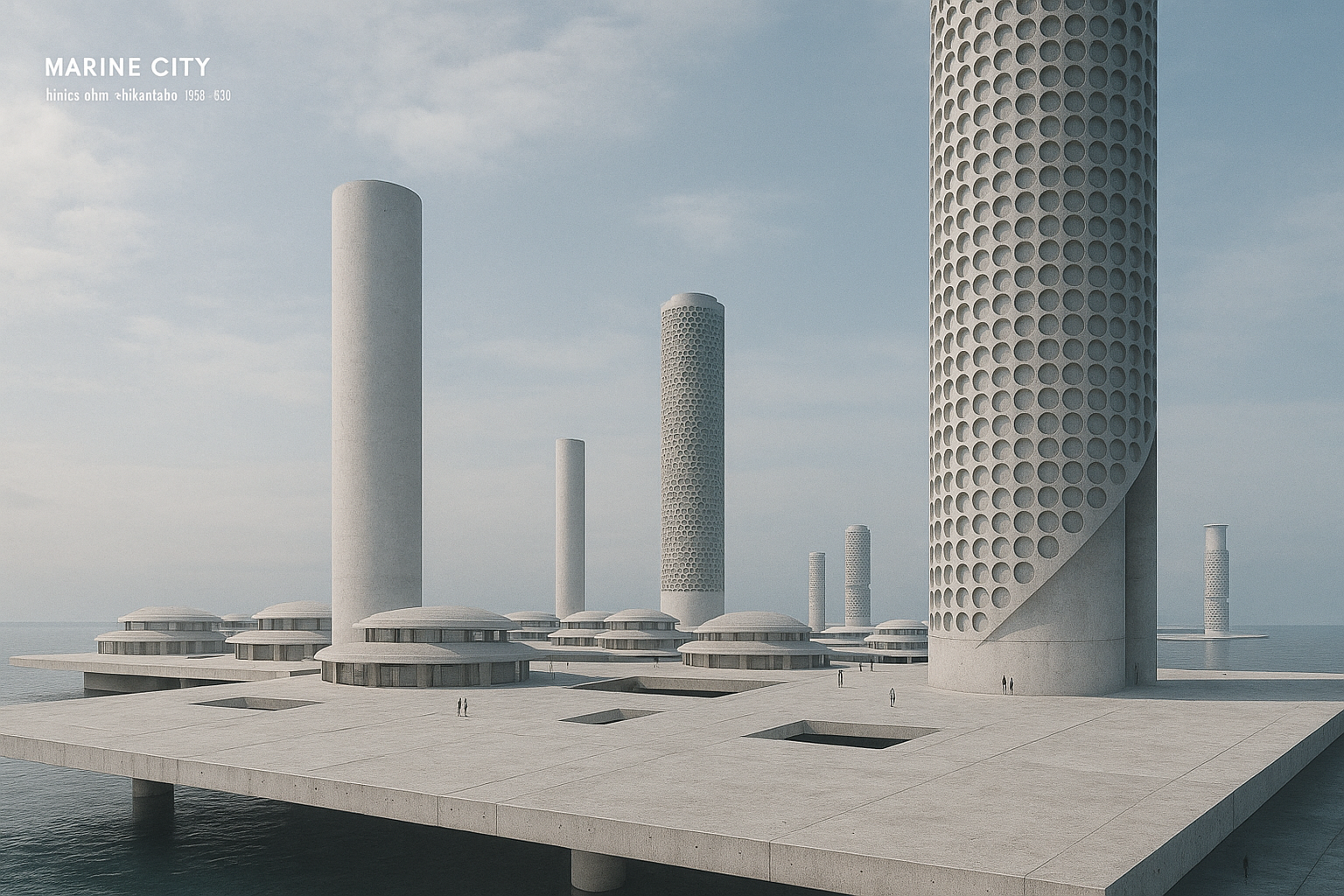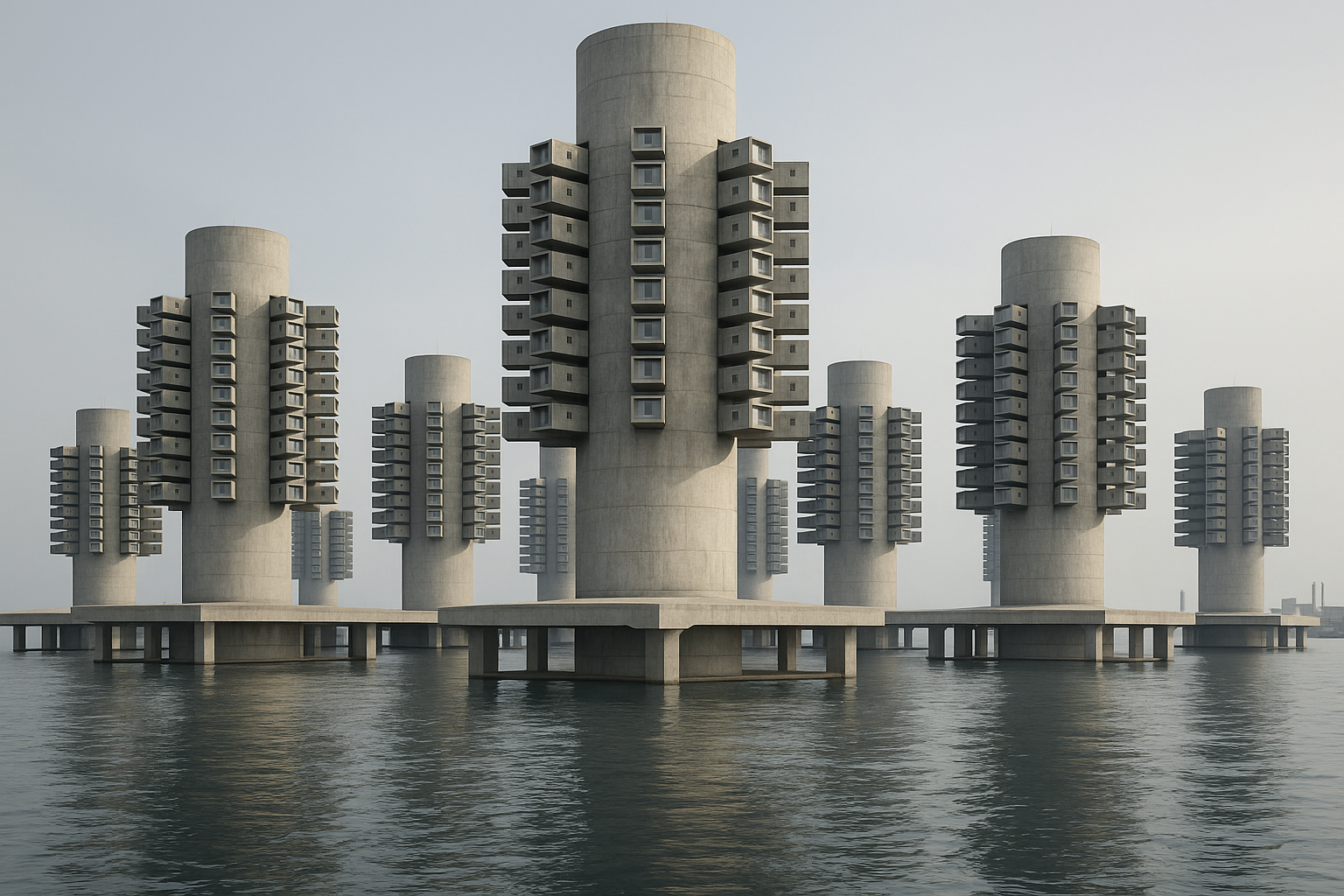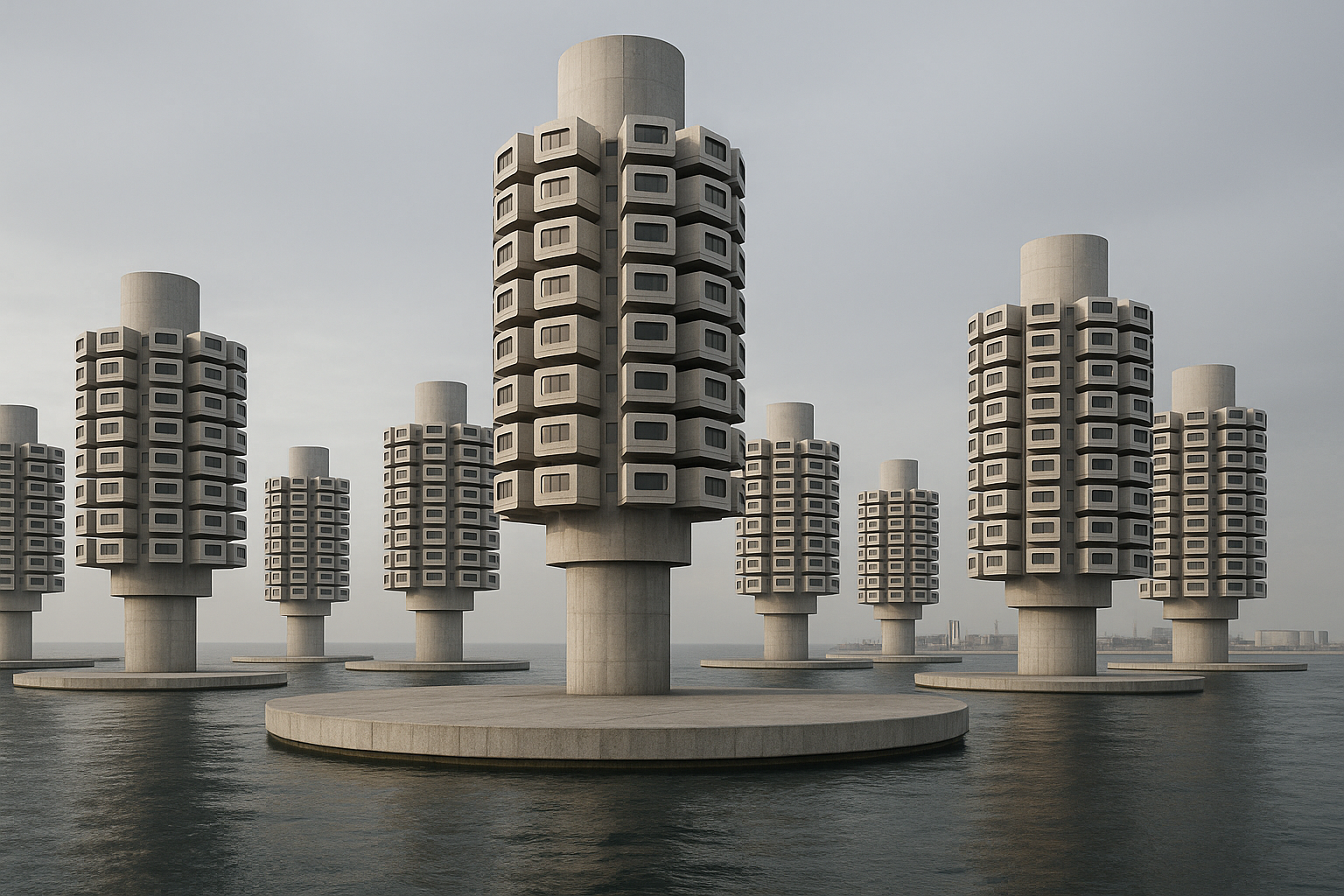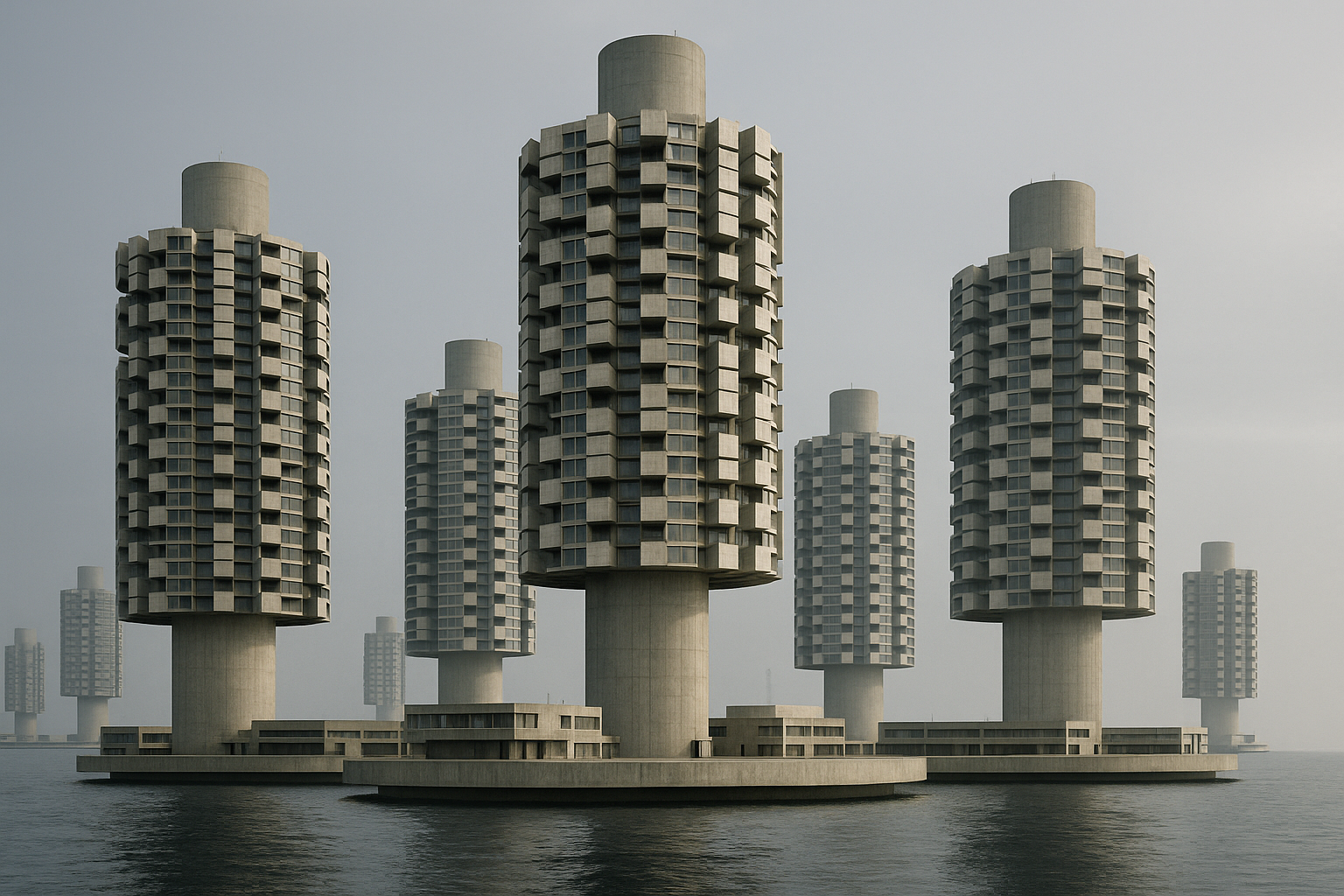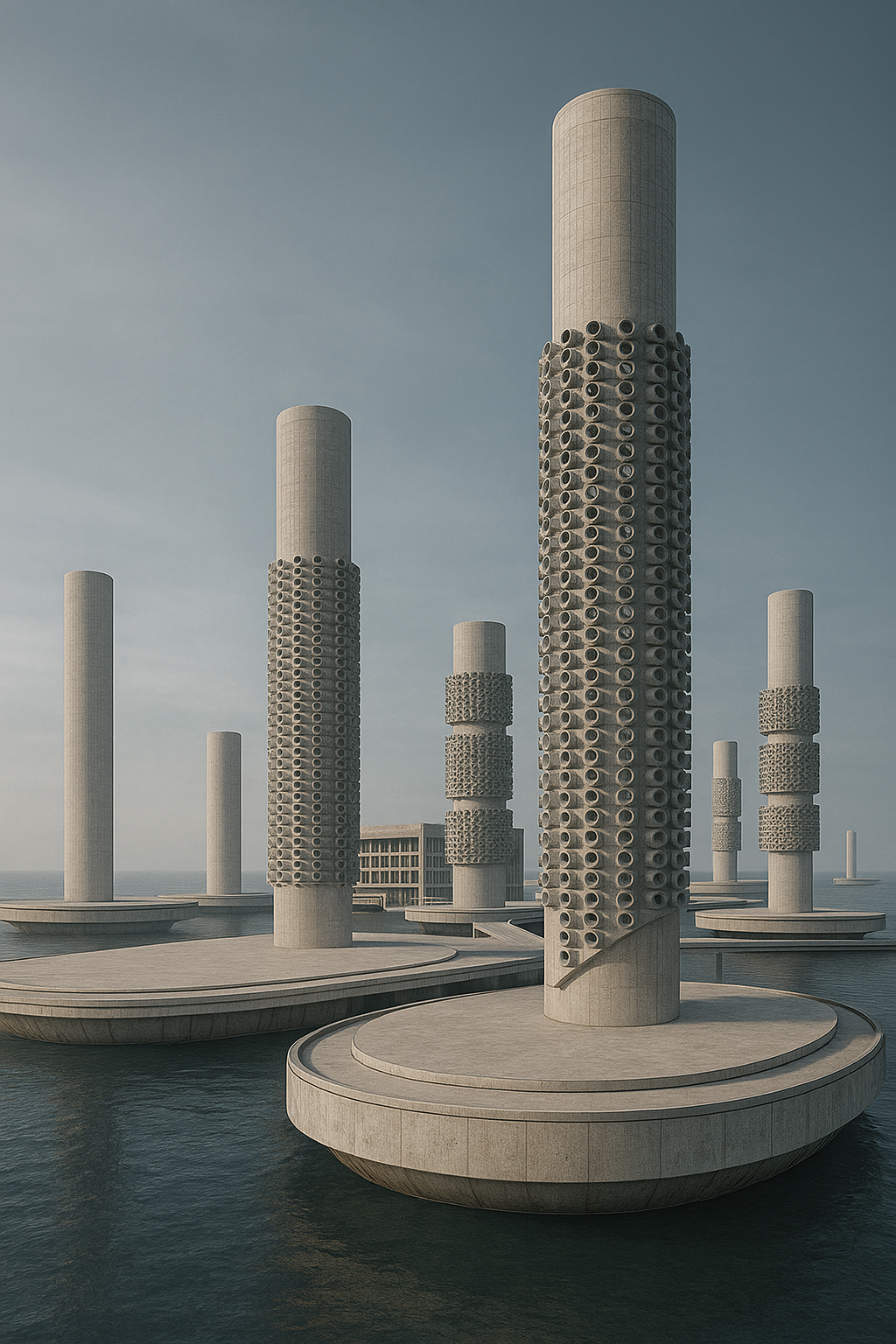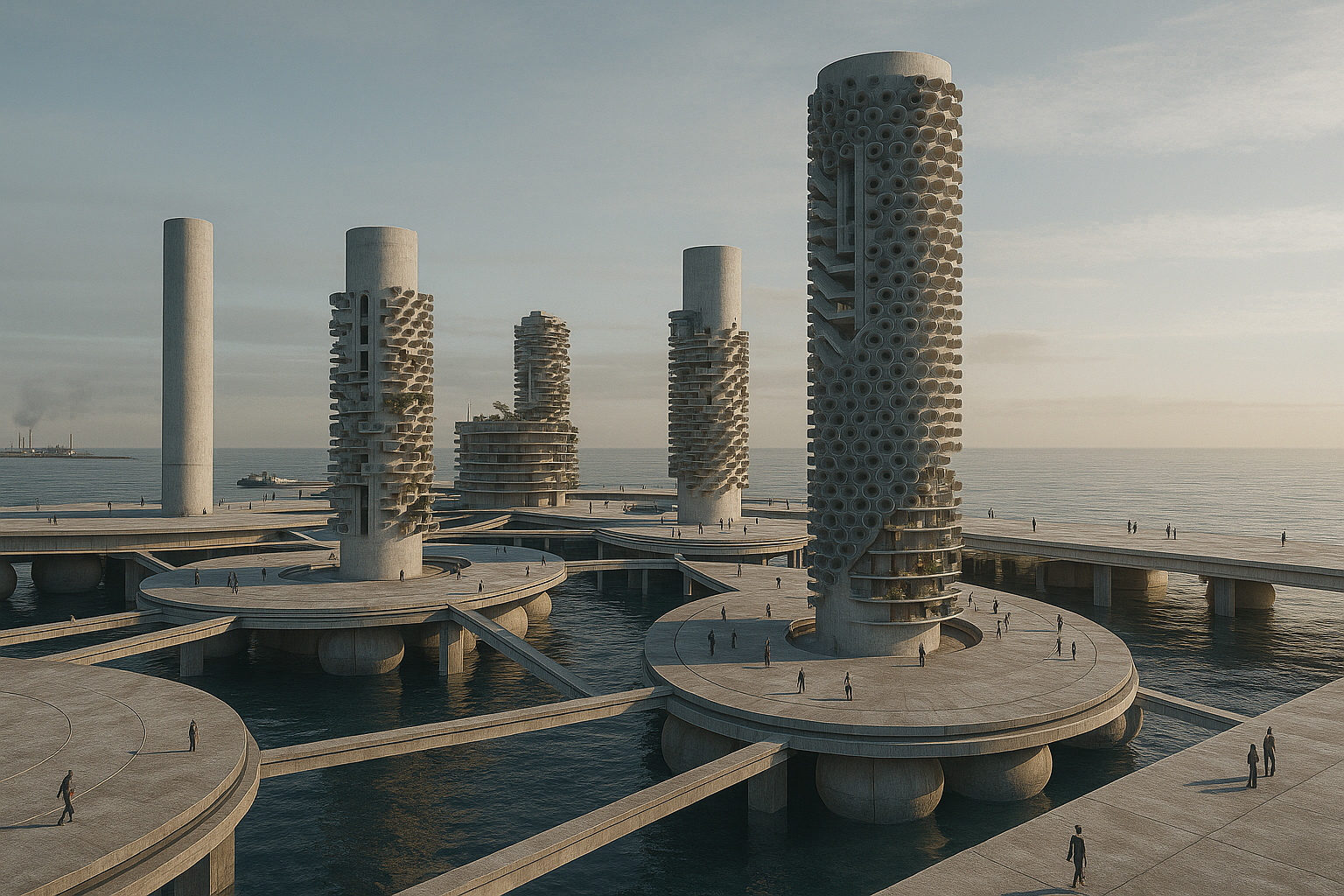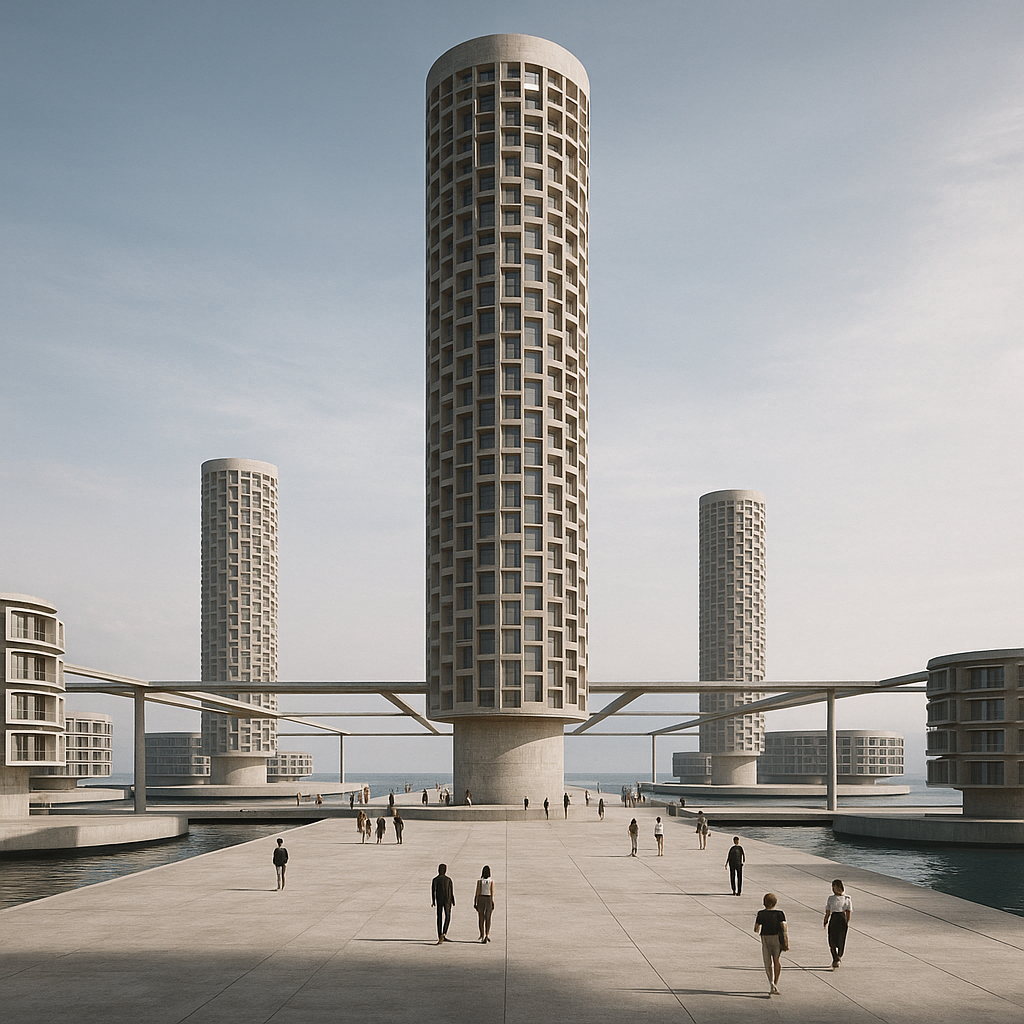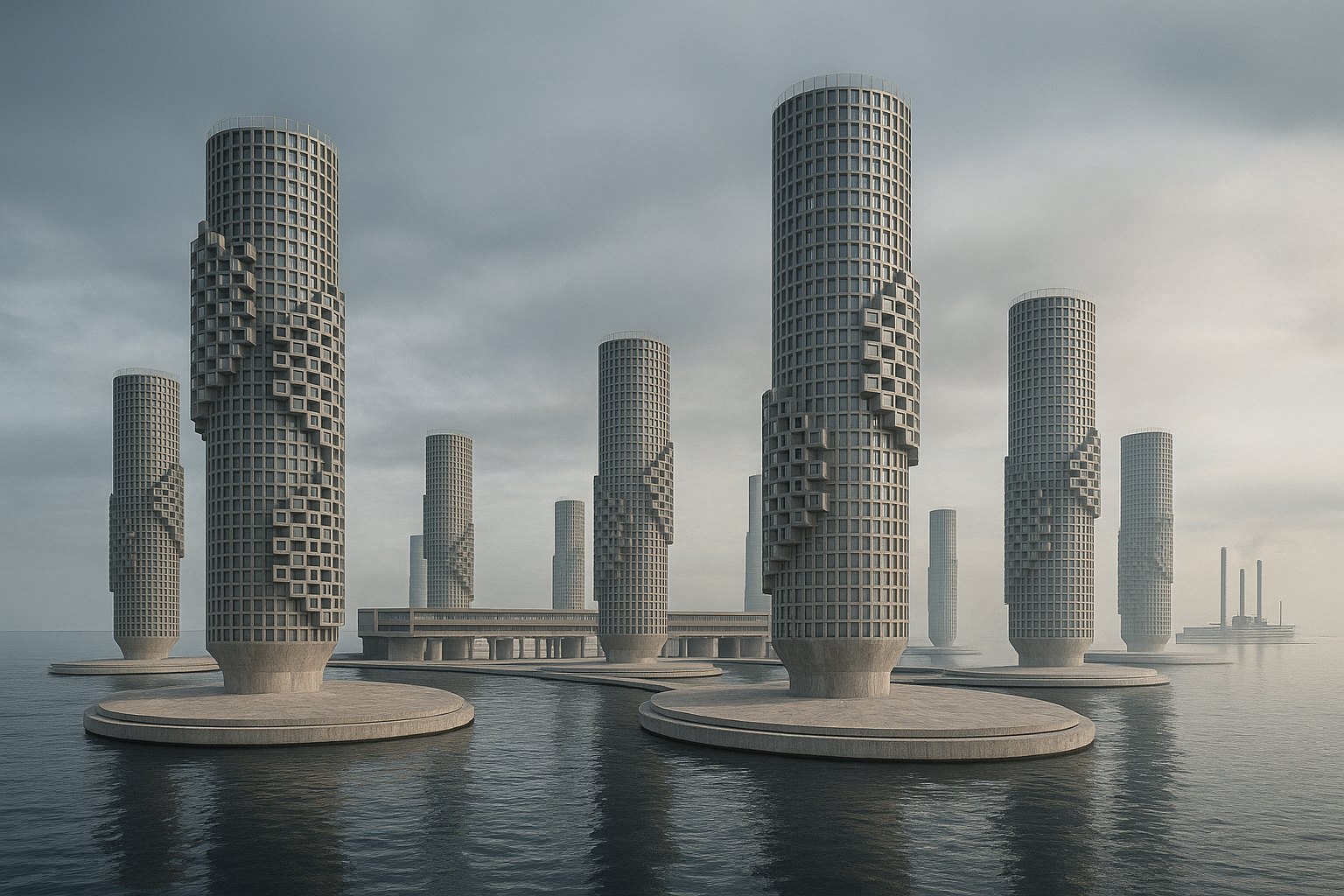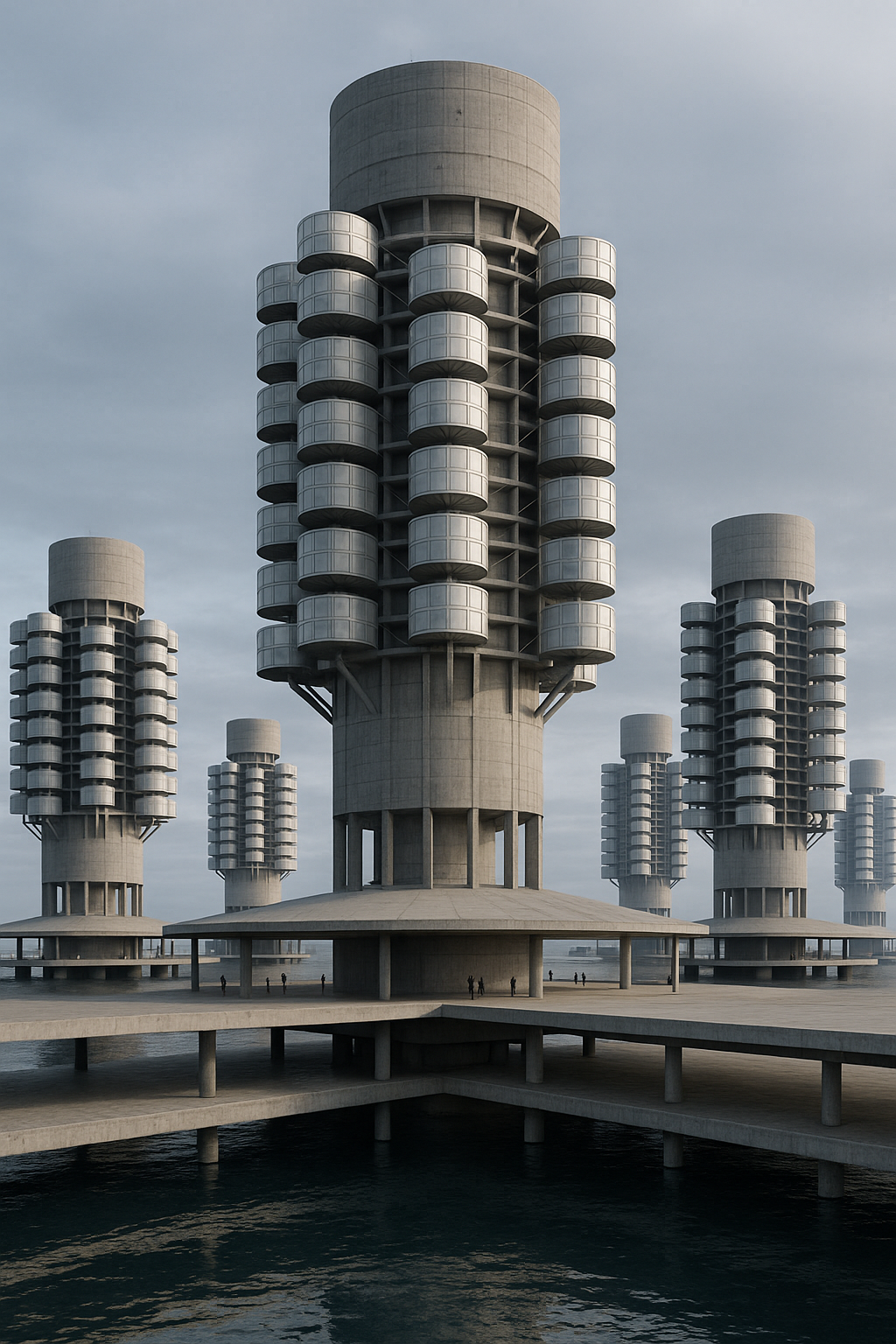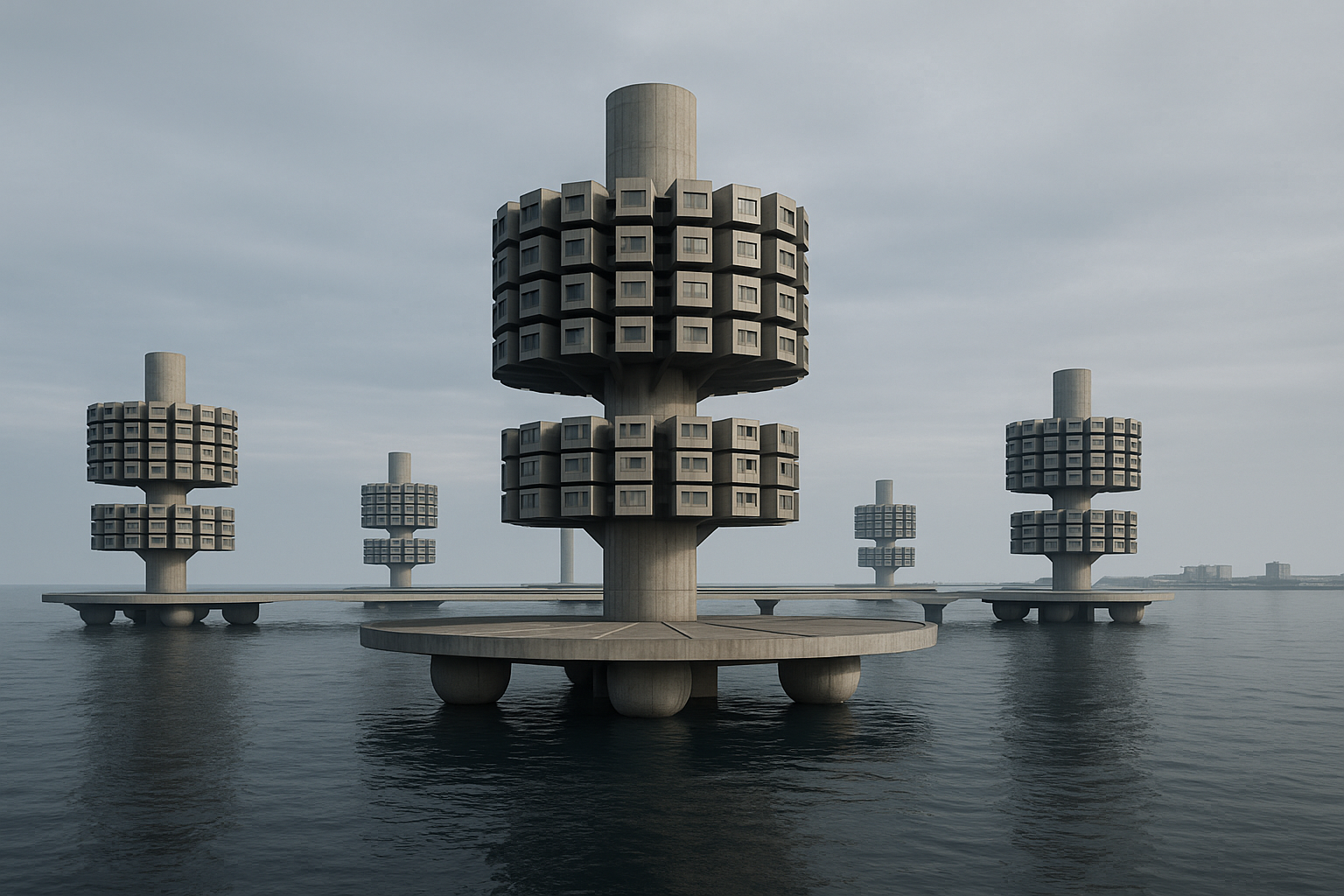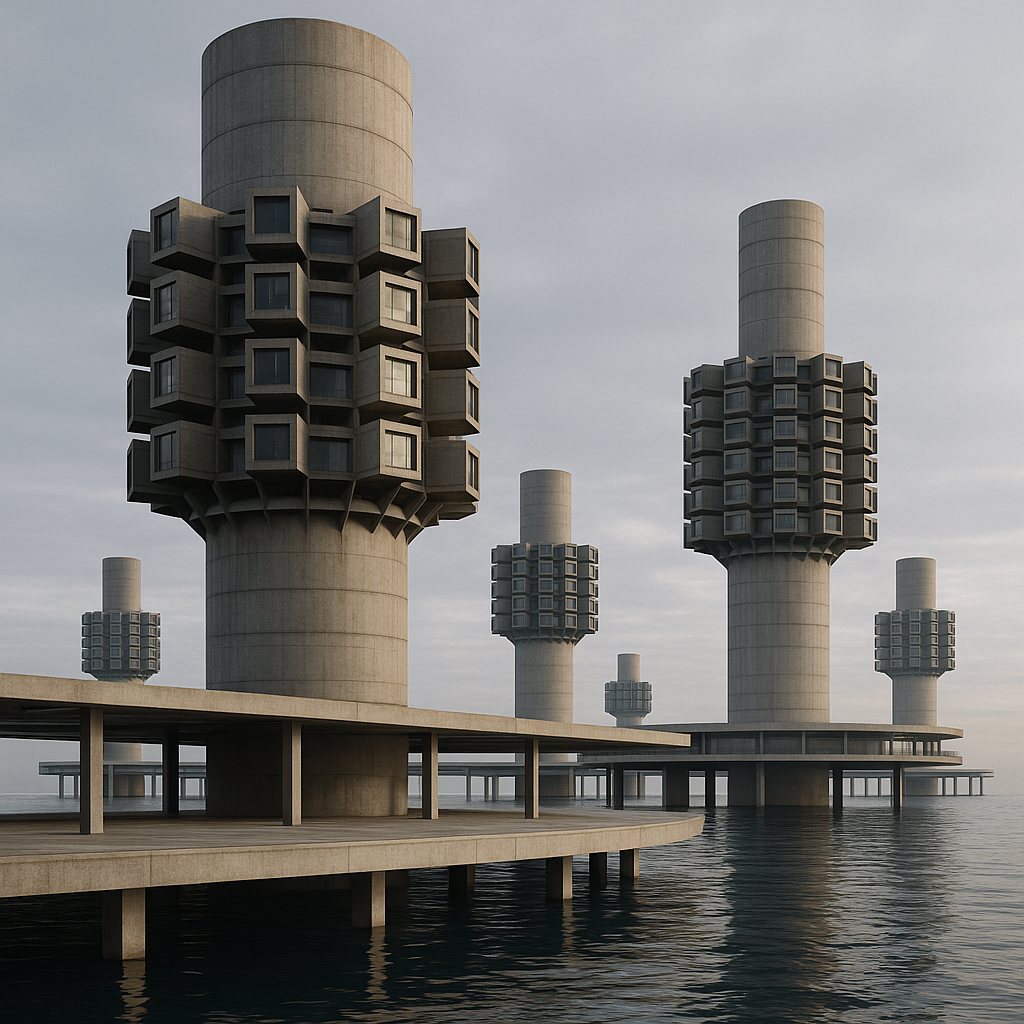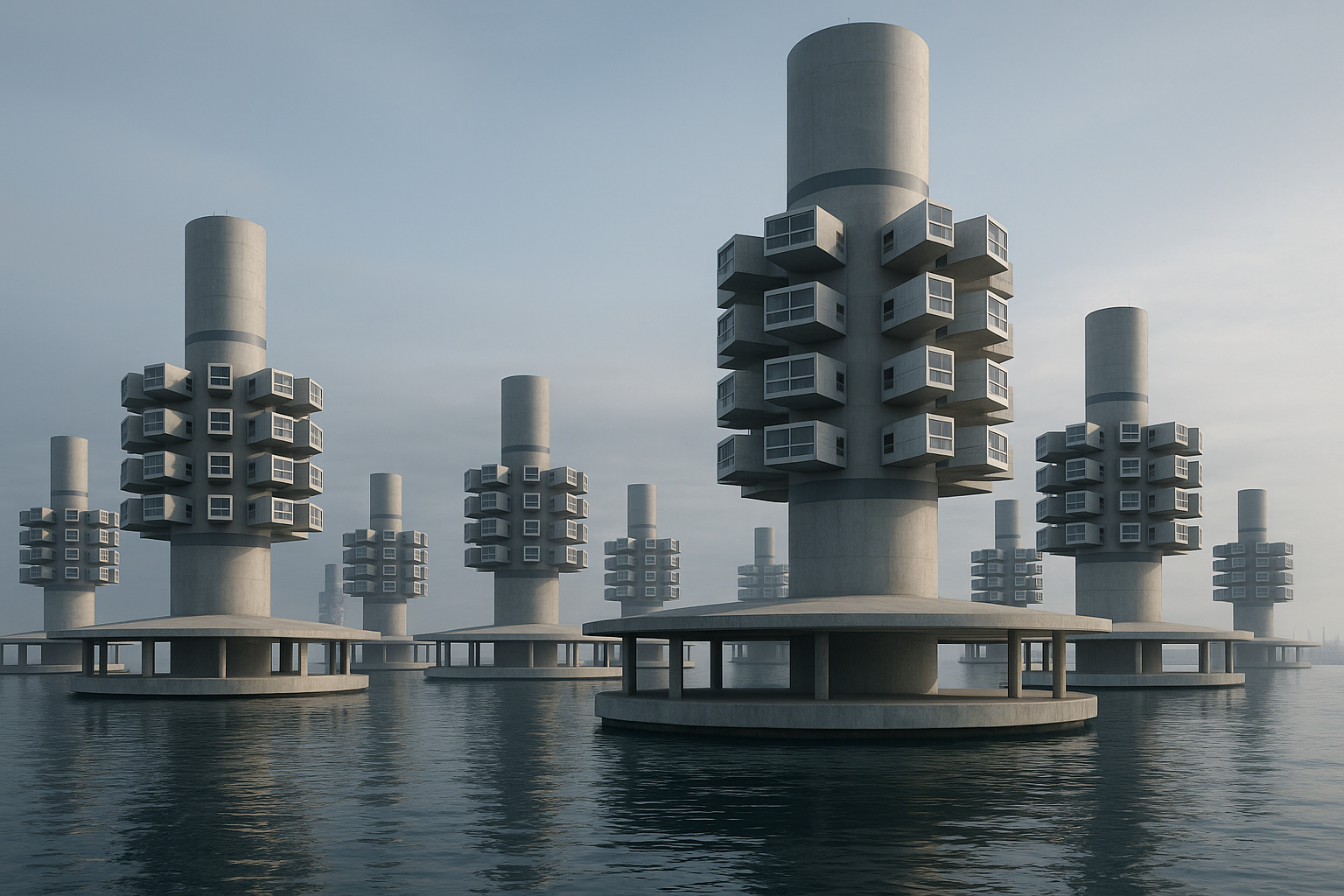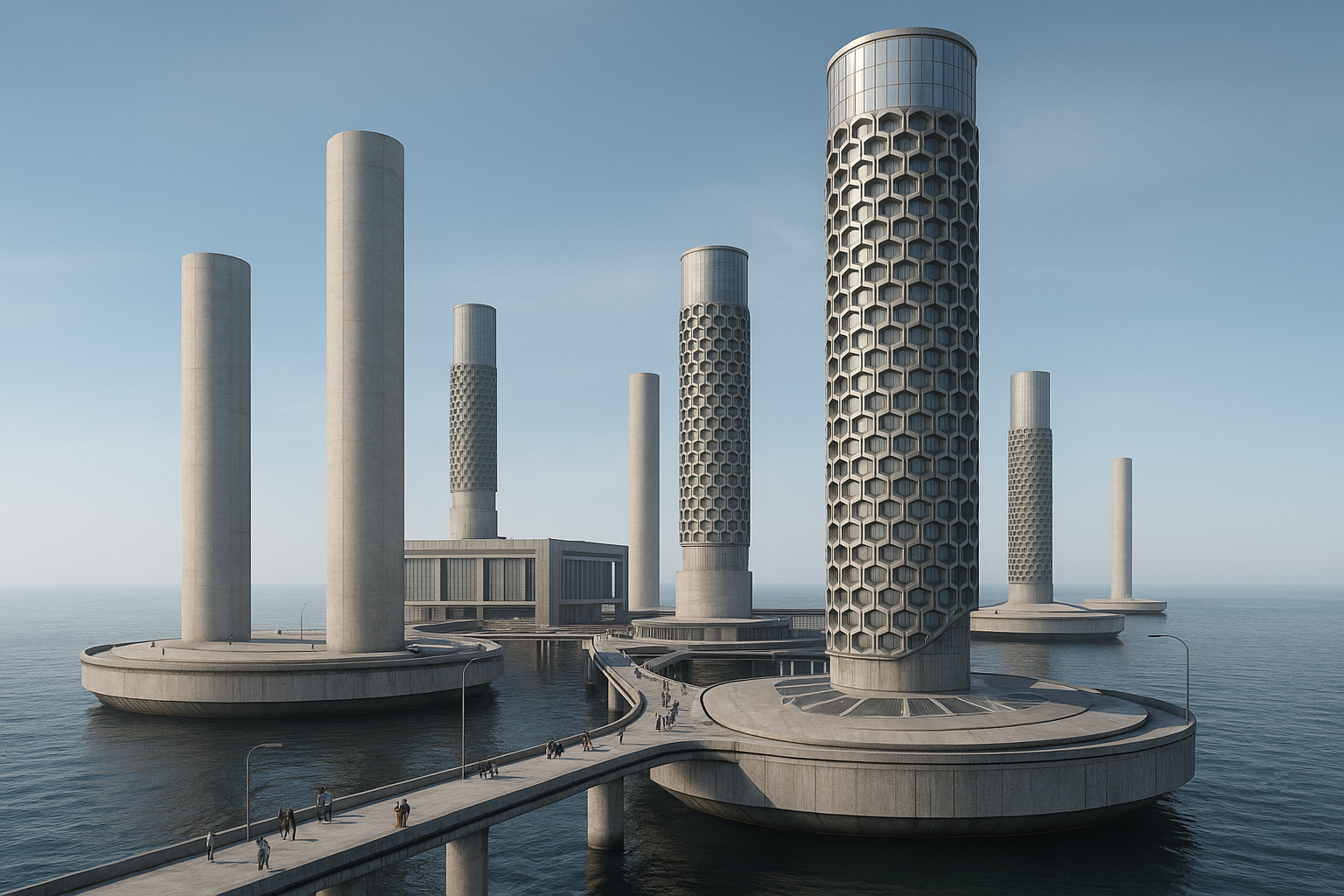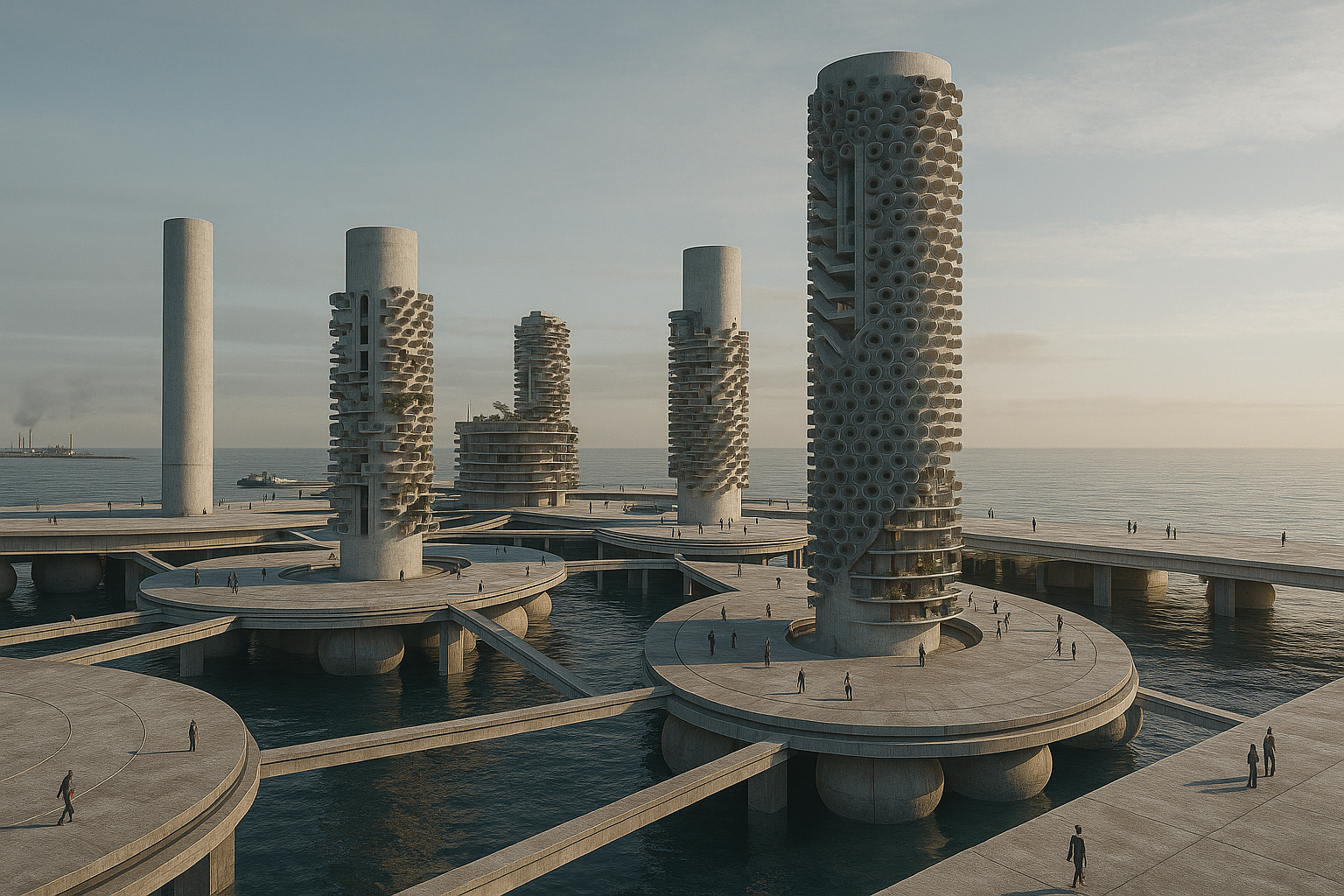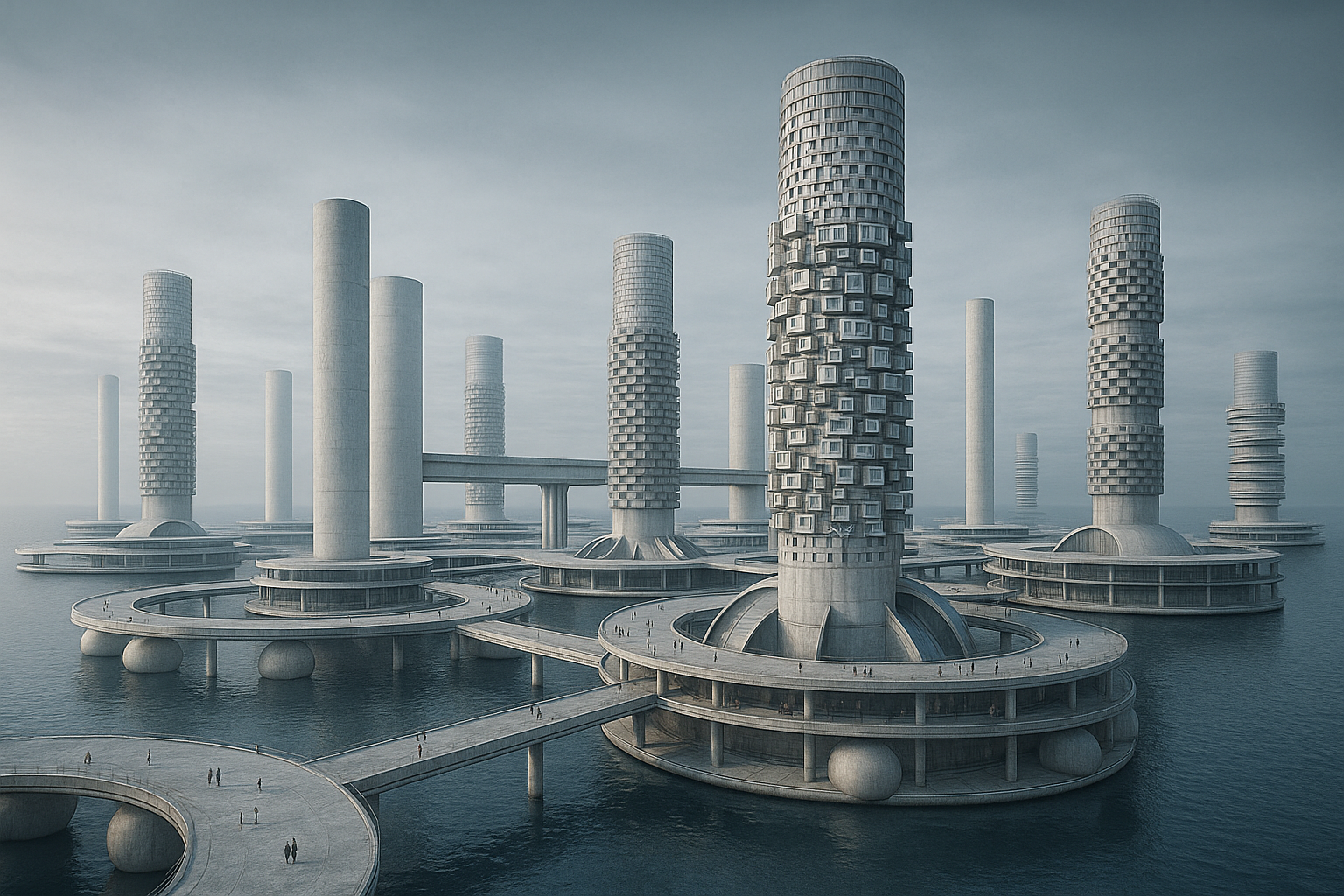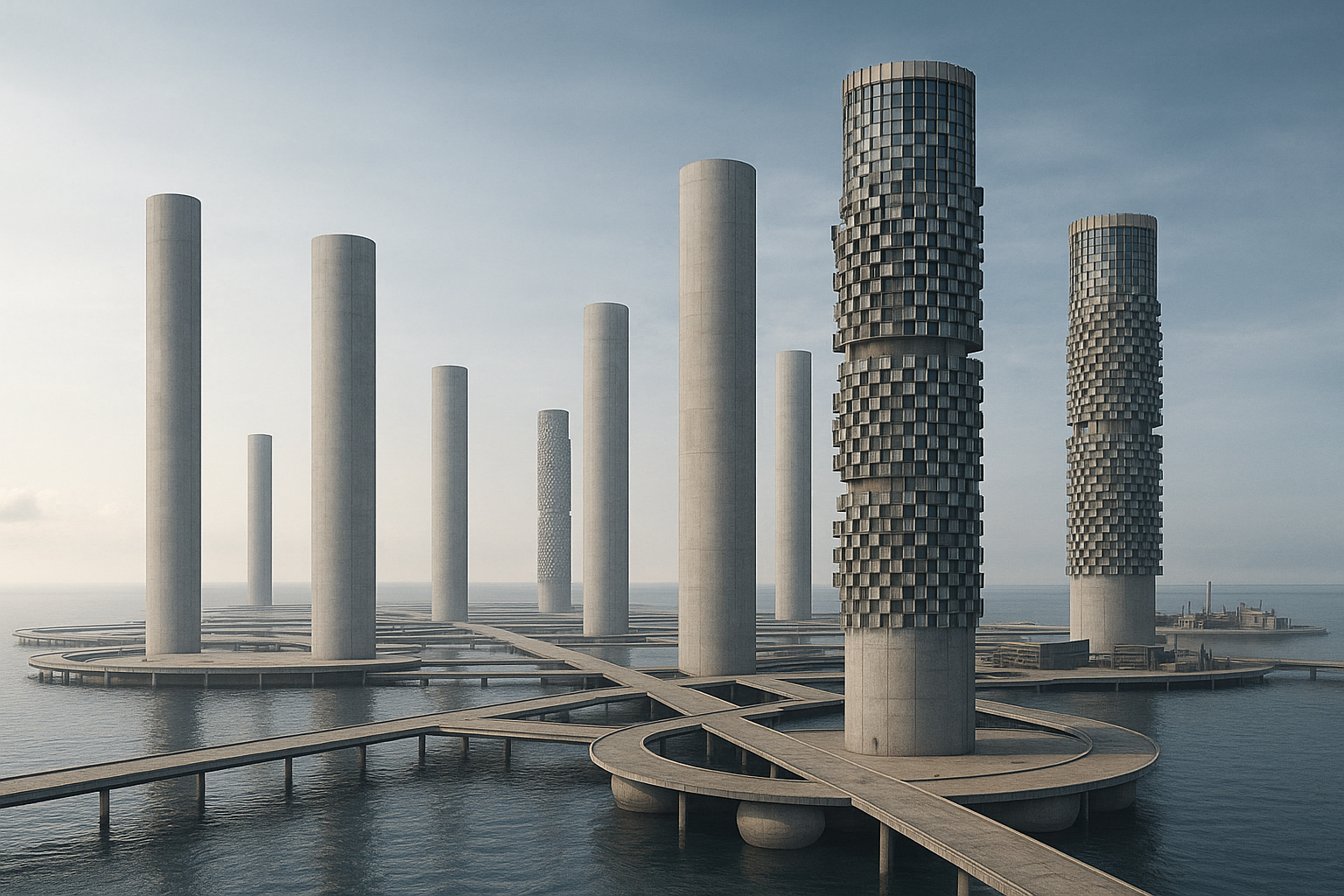Marine City de Kiyonori Kikutake
Principais características
Prompt positivo: Ultra-realistic 8K architectural visualization, eye-level perspective of Marine City, the utopian city envisioned by Kiyonori Kikutake between 1958 and 1963. Conceived as a living organism, the city responds to the dynamic conditions of postwar urban Japan — reflecting rapid population growth, accelerated urban development, and continual spatial transformation.
Marine City emerges as a floating metropolis, anchored in the sea, where vertical towers and megastructural platforms support both permanent and temporary architectural elements. The city accepts and integrates change, embodying the core principles of the Metabolist movement — architecture as an evolving system capable of adapting to social and environmental flux.
From street level, massive residential towers rise from floating platforms, connected by bridges and modular units. The structures are flexible and expandable, designed to accommodate future growth and reconfiguration. The architectural language emphasizes functional verticality and structural innovation, with photorealistic textures of concrete, steel, and marine infrastructure under diffused natural lighting. The water’s surface reflects the monumental forms above, reinforcing the impression of a city suspended between sea and sky — a resilient, ever-transforming urban organism.
Prompt negativo: low resolution, traditional land-based cityscapes, rigid urban grids, vegetation or natural parks, historical ornamentation, fantasy or sci-fi themes, postmodern or decorative elements, curved organic shapes, hand-drawn styles, cartoonish or colorful features, sunset or golden-hour lighting, aerial or isometric perspectives, suburban sprawl, digital signage, cyberpunk aesthetics, minimalism, static or unchangeable architecture.
Imagens produzidas pelo Chat GPT a partir de entradas de texto
Características formais
Prompt positivo: Ultra-realistic 8K architectural visualization, eye-level perspective of Marine City, the utopian ocean-based city imagined by Kiyonori Kikutake between 1958 and 1963. The entire urban system is based on cylindrical geometry. Cylindrical living units are clustered around massive suspended cylindrical towers, all anchored to floating circular islands supported by buoyant spherical bases. These structural cores repeat across the seascape, forming a modular, expandable network of vertical megastructures.
Each of the city’s towers reaches up to 500 meters in height, emerging from a vast floating platform that forms the base of the city-island. The residential cells replicate around the central cores, forming radial compositions that reinforce both spatial efficiency and visual unity. The floating structure is engineered for seismic flexibility and flood resilience, showcasing an advanced level of architectural technology and environmental responsiveness.
The architectural language follows the bold, futuristic vocabulary of the Metabolist movement — modular repetition, structural expressiveness, and visionary scale. Rendered with hyper-detailed textures of raw concrete, brushed steel, and matte composite membranes, the scene is set in open ocean daylight, with subtle reflections on water and a neutral gray-blue sky. The perspective captures the monumental scale and techno-utopian spirit of a city designed to evolve, float, and resist nature’s extremes.
Prompt negativo: low resolution, static terrestrial cities, rectangular grids, vegetation or greenery, classical or historical ornamentation, suburban sprawl, colorful toy-like architecture, postmodern features, fantasy or sci-fi elements, hand-drawn style, sunset or golden-hour tones, aerial or isometric views, minimalism, nature-dominant landscapes, glossy materials, soft or whimsical aesthetics, digital signage, cyberpunk effects.
Imagens produzidas pelo Chat GPT a partir de entradas de texto
Características de Infraestrutura de Mobilidade
Prompt positivo: Ultra-realistic 8K architectural visualization, eye-level perspective of Marine City, the oceanic utopian city imagined by Kiyonori Kikutake between 1958 and 1963. The city’s entire circulation system is vertical, conducted through mobile transport elements that move within the massive central cylindrical towers. These high-tech vertical cores serve as both structural and circulatory spines, efficiently connecting the floating city’s various levels and modules.
Set on expansive circular platforms floating on the ocean surface, each tower rises from the water, surrounded by cylindrical living units that are modular, adaptive, and repeat across the seascape. The visual language reflects the architectural ethos of the Metabolist movement: futuristic, dynamic, and open to continuous evolution. Every component of the city is designed with structural clarity and functional logic — emphasizing adaptability, resilience, and vertical integration.
Rendered with hyper-detailed textures — raw concrete, matte steel, and translucent composite materials — under diffused daylight with soft shadows and ocean reflections. The scene highlights the scale and precision of the vertical transportation system, the symmetry of the cylindrical forms, and the technological ambition of this visionary floating metropolis.
Prompt negativo: low resolution, flat urban landscapes, horizontal-only circulation, natural vegetation or gardens, historic ornamentation, warm sunset lighting, aerial or isometric views, colorful or cartoonish architecture, organic or curvilinear designs unrelated to cylinders, suburban environments, fantasy elements, sci-fi aesthetics, cyberpunk style, postmodern features, glossy materials, minimalist structures, hand-drawn appearance.
Imagens produzidas pelo Chat GPT a partir de entradas de texto
Características dos Espaços Verdes
Prompt positivo: Ultra-realistic 8K architectural visualization, eye-level perspective of Marine City, the oceanic utopian city envisioned by Kiyonori Kikutake between 1958 and 1963. Floating above the water’s surface, the city features a vast, open horizontal structure — a free, elevated platform designed as a shared social space for interaction, movement, and collective activity among its inhabitants.
This expansive plane is anchored by cylindrical towers and floating modules, characteristic of the Metabolist architectural language. The open structure allows flexibility of use, reflecting the city’s commitment to modular adaptability, public engagement, and spatial freedom. There are no barriers or enclosures — only an engineered framework that invites human presence, creativity, and reconfiguration.
The platform hovers just above the ocean, supported by buoyant structural systems, with a clear view of the endless sea on all sides. Rendered in soft natural daylight with photorealistic textures — raw concrete slabs, matte steel framing, and subtle water reflections — the image captures the serene yet technologically ambitious vision of a floating city designed for a fluid, post-industrial society.
Prompt negativo: low resolution, land-based urbanism, dense vegetation, historical or classical ornamentation, warm tones or golden-hour lighting, colorful architecture, suburban buildings, postmodern or deconstructivist elements, fantasy or sci-fi influences, aerial or isometric views, hand-drawn or stylized aesthetics, minimalism, cyberpunk effects, curved organic structures, glossy materials, rigid spatial zoning, digital screens.
Imagens produzidas pelo Chat GPT a partir de entradas de texto
Características Espaciais e Funcionais
Prompt positivo: Ultra-realistic 8K architectural visualization, eye-level perspective of Marine City, the oceanic utopian city imagined by Kiyonori Kikutake between 1958 and 1963. At the heart of this floating metropolis, permanent cylindrical towers rise up to 500 meters in height, distributed rhythmically around a central structural platform. These monumental vertical cores are conceived as living trees, while the modular housing units attached to them are seen as leaves — adaptable, replaceable, and responsive to the changing seasons and the evolving needs of their inhabitants.
Each tower supports a dynamic array of residential cells, which can be modified, removed, or replaced over time, embracing Kikutake’s vision of a living architecture. The towers are exclusively dedicated to individual housing, reinforcing personal autonomy within a collective urban organism. Around the perimeter of the city, industrial facilities are strategically located, maintaining distance from residential zones and emphasizing functional zoning within the floating system.
The entire city is anchored above the ocean, with photorealistic architectural elements — exposed concrete, matte steel, and modular paneling — rendered in soft daylight under a gray-blue sky. Reflections shimmer across the water, and the repetition of the towering vertical forms emphasizes the city’s metabolist identity: a technologically advanced, ever-evolving urban environment in perfect harmony with change.
Prompt negativo: low resolution, traditional cities with fixed architecture, rigid rectangular forms, historical ornamentation, vegetation or green parks, curved organic shapes, warm golden-hour lighting, aerial or isometric views, fantasy architecture, postmodern decoration, cyberpunk or sci-fi aesthetics, suburban housing, colorful or cartoon-like elements, polished or glossy surfaces, hand-drawn or minimalist style, asymmetrical low-rise layouts, natural landscapes, static environments.
Imagens produzidas pelo Chat GPT a partir de entradas de texto
Todos os prompts anteriores.
Prompt positivo: Ultra-realistic 8K architectural visualization, eye-level perspective of Marine City, the visionary oceanic utopia imagined by Kiyonori Kikutake between 1958 and 1963. Conceived as a living organism, the city responds to the dynamic conditions of postwar urban Japan — rapid population growth, accelerated urbanization, and spatial transformation. Floating over the ocean, Marine City emerges as a vast, modular metropolis anchored in a network of circular islands supported by buoyant spherical bases.
At the heart of the system, monumental cylindrical towers — reaching up to 500 meters high — rise from floating structural platforms. These towers are envisioned as vertical “trees,” while the modular living units attached to them act as “leaves” — adaptable and replaceable according to seasonal change and human need. Residential cells are arranged radially around the tower cores, forming efficient, scalable, and responsive vertical communities. The towers are dedicated to individual living, while industrial facilities are located at the city’s periphery, maintaining clear functional zoning.
The city’s entire circulation is vertical, operated through high-tech transport systems moving inside the central cylindrical spines. Horizontal platforms extend across the water’s surface, forming open public spaces — expansive and free, designed for collective interaction, creativity, and reconfiguration. These spaces hover just above the ocean, with unobstructed views of the sea and sky, reinforcing a sense of suspension and freedom.
Architecturally, Marine City embodies the bold vocabulary of the Metabolist movement: repetition, transformability, and visionary scale. Photorealistic textures of exposed concrete, matte steel, translucent composite membranes, and reflective water surfaces are rendered under diffused daylight and a gray-blue sky. The image captures a technologically advanced, seismic-resilient, and flood-proof urban organism — in continuous transformation, suspended between nature and imagination.
Prompt negativo: low resolution, land-based cities, organic shapes, vegetation or green roofs, classical ornamentation, postmodern features, suburban sprawl, fantasy or sci-fi themes, minimalism, golden-hour lighting, aerial or isometric views, cartoonish style, glossy surfaces, static urban layout, asymmetrical low-rise buildings, cyberpunk aesthetics, nature-dominated landscapes, enclosed parks, hand-drawn or flat textures.
Imagens produzidas pelo Chat GPT a partir de entradas de texto
